




Ethan Moran Sports Editor
Students formed a wall of white on Franke Field. School merchandise, apple cider donuts and burgers filled tents near the Nicholas Athletic Center. Lower School kids jumped in bouncy houses amid the growing mountain of foam sprayed from a bubble machine.
It was all part of the school’s effort to celebrate Homecoming from Oct. 17–18 and spread school spirit.
The senior prefects and Assistant to the Dean of Students Kerri Anne Shea organized Spirit Week. From Oct. 16–24, students dressed up in school colors and wore themed clothing, like Pajama Day and Boston Day.
“Spirit Week brings a good amount of school spirit and is important for advertising Homecoming,” senior prefect Amanda Berlin ’26 said. “I like the traditional high school vibe that it brings. But also, not a lot of people participate.”
The school’s size may contribute to its lack of school spirit.
“It’s harder for us because we have fewer students, while at big public schools, more people are advocating for it,” Amanda said.
“We have the senior prefects, but it’s only 12 of us. At bigger schools, it could be a huge student council committee. Considering that we’ve got 500 students in the school building, we’re doing a pretty good job.”
CONTINUED ON PAGE 6
Reckoning with representation US theater struggles to cast key ‘Crucible’ character
Gabe Cooper Editor–in–Chief
When the Upper School (US) fall play cast started rehearsing Arthur Miller’s “The Crucible,” one role proved harder to fill than expected. Tituba, an enslaved woman whose accusation sparked the Salem witch trials, has become the center of US conversations about identity and representation in theater. US Theater Director Ross MacDonald said the challenge of casting Tituba raises
larger questions: How do we tell the hard stories without silencing them, and who can — and should — tell them?
Tituba is the first character accused of witchcraft in “The Crucible.”
“Witches at this time were used as the scapegoat for all other things that were happening,” Mr. MacDonald said. “Salem Village was breaking away from Salem, and these accusations were coming in: ‘Are they getting blamed for the bad crops? Are they getting blamed for the instabil-

Many Upper School (US) students have experienced the same type of stress: showing up to class the day a group project is due, only to find that the other group members have not completed their parts. While teachers assign group work to promote collaboration, some students see these projects — often resulting in an unequal distribution of work — as frustrating.
US History Teacher Susan Glazer incorporates group projects into her classes.
“Student agency, collaboration, leadership and how you work in a group: These are skills that are at the core of a group project,” she said. “In the real world, you need to work with other people. Sometimes, it’ll be your friends that you can really trust, but sometimes, it will be people you’ve never worked with before.”
Students often worry about how much group projects count toward their grade.
“Group projects can vary in terms of weighting,” Dr. Glazer said. “Generally, a group project is not weighted as much as an individual assessment. That being said, if there is an independent portion of a group project, that could equalize the weighting.”
CONTINUED ON PAGE 9

ity? Are they getting blamed for the fearmongering?’”
Mr. MacDonald can relate to the play through his experience immigrating from Scotland.
“What Miller is trying to say is we blame those people who we view as inferior or view as ‘other,’ which is what’s happening in America with blaming immigrants,” Mr. MacDonald said. “Because of my experiences as an immigrant, I have some practical understanding as well as a huge deal of empathy and compassion for
these people who are being hounded and blamed for everything. If we can’t show that, not only do we miss an important part of the story, but we do an injustice to the real Tituba. We don’t tell her story. And if we start canceling ourselves because we don’t want to tell uncomfortable stories, I fear that we’re just like the people who want to ban books.”


If you observe the Commons at about 1 p.m. — just after lunch — you might notice a sea of Starbucks cups and Celsius cans sprinkled across the tables, much to Ms. Shea’s dismay. But what’s with the unprecedented influx of beverages? What’s with the need to have a drink as an appendage 24/7?
At such an academically-demanding school, it’s understandable that students might choose to befriend caffeine. However, as much as we here at The Vanguard enjoy a good mocha with cold foam or the more seasonal pumpkin spice latte, it’s likely that ingesting a can of Celsius (200 milligrams of caffeine) and a venti/trenta/ariana/grande cup of coffee (100 milligrams of caffeine) might not be fantastic for our heart health in the long-run.
A caffeine rush likely isn’t the only reason for our dire necessity to have a cup in hand, so perhaps it is the feeling of the drinks that we chase; perhaps we just want to play grown-ups. After all, a morning cup of Joe is ingrained in the widely-accepted perception of a daily routine whether we witness it in cartoons or our parents’ lives. And while we stu-

dents might not be ready to experience the horrors of adulting — getting dressed up each day and filing taxes and things — perhaps we do want to embody
Buckingham Browne & Nichols School 80 Gerry’s Landing Road Cambridge, MA 02138 vanguard@bbns.org, vanguard.bbns.org (617) 547-6100
Volume 54, Issue 5
Projects Editor Ayana Karthik
Opinions Editor Matthew Walsh
Editorials Editor Sonja Peetz-Larsen
On Campus Editor Mimi Shaywitz
Off Campus Editor Lucia Longstreet-Lipson
Features Editor Scarlett Hawkins
Sports Editor Ethan Moran
Editor-in-Chief Gabe Cooper Managing Editor Yancheng Zhao

Arts Editor Christine Tao
Faculty Advisor Kim Whitney
Production Manager Carl Chen
Production Manager Charlotte Garrity
Digital Media Editor Vartan Arakelian
Asst. Production Manager Sydney Ruiz
Asst. Production Manager Harper Dubovik
Photo Editor Olivia Richter
Asst. Photo Editor Katy Varadi
The Vanguard’s mission is to examine and engage the school community by providing news and information about events affecting it and by featuring the diverse range of people and perspectives that comprise it. We strive for fairness and accuracy in our content, and we strive to present that content with integrity and respect.
The Vanguard is the official student newspaper of the Buckingham Browne & Nichols Upper School, which has 534 students, 84 faculty members, and 64 staff members. Affiliated with the Columbia Scholastic Press Association, the paper is a forum for differing views and welcomes comments from its readers in the form of Letters to the Editor. No anonymous letters will be printed. The Vanguard reserves the right to edit all letters for length. The Vanguard publishes eight issues per annual volume and prints between 500 and 800 copies of each issue. About 200 of those are mailed out; the rest are distributed around campus.
Copyright © 2025 The Vanguard
Staff Writers:
Hailey Jiang, David Xiong, Lucy Song, Annie Zhu, Finn Konary, Aggie Grant, Olivia Bell, Sydney Xu, Leah Cooper, Maggie Whitney, David Zhou, Pilar Bowen-Arce, Robbie Lally
Staff Photographers: Ash Surati, Caroline Dudzinski, Ryan Figlioli, Danny West, Shirley Zhu, Hailey Jiang, Yancheng Zhao, Gabe Cooper, Azariah Zewde
Staff Artists: Isabel Doricent, Alice Wang, Lauren Li, Sydney Ruiz, Sydney Xu, Rachel Goldberg, Christine Tao, Marin MacDonald
the go-getter, determined adults in our lives through a simple morning coffee.
It appears as though we’re passing our imitation down to Gen Alpha, too: 12-year-olds with a full face of makeup, Apple Watches and Snapchat have taken the internet by storm, leaving some wondering why these children are choosing to opt-out of a real childhood. However, don’t you remember feeling beautiful when your mom let you borrow her eyeshadow? Remember when your dad let you play games on his phone? Didn’t you feel cool and grown-up?
These Sephora kids appear to be chasing the same serene sensation that we do with our coffee, just through mountains of skincare and blush; the makeup brands are devouring it, too, targeting children through their online marketing.
Regardless of the joy that 11-year-olds feel after downloading Instagram, these kids are missing out on a carefree childhood. Developing such mature hobbies at such a young age ruins the fun of it later in life, too.
So, instead of clutching a tray of caffeinated beverages to our chests, let’s develop a mindset that is focused on the long run. Savor these moments in which caffeine doesn’t need to be a lifeline, these moments in which we get excited about the rare treat of a root beer float or a Sprite.
Don’t rush to grow up because, before you know it, your precious childhood and teenage years will be over. Save the drinks for when you enter college or even become a parent, both times when you are really going to need that caffeine.
Bottom line, however, clean up your empty cups in the Commons.
Within the last few years, an influx of teenage boys with ice-cream-scooped shaped hair and a severe lack of emotion took social media and American high schools by storm. The phenomenon dubbed “nonchalance” has left teens with their heads tilted slightly back in an air of negligence, all while sporting hoodies and skinny sweatpants tucked into their socks. Unfortunately, the uptick in nonchalance has trickled down to the student body, taking a toll on the vibrancy of student life here at the school — and not just because of the “super cool” tucked-in sweatpants.
Let’s take Spirit Week, for example. School spirit is meant to be an exciting method of uniting students in costume, color or clothing. It appears as though we are simply too cool to participate in school spirit, however, given that hardly anyone dressed up this year. Even some senior prefects (who chose the themes) opted-out of Spirit Week.
The same victims of the nonchalance craze have somehow mastered the strange marriage between having a massive ego and acting like they don’t care. It’s infuriating.
These kids ignore their friends in the hallways because they can’t be caught in the act of smiling (a visible display of emotion … oh no!). Class discussions are a nightmare, too; openly demonstrating a passion for the material at hand could be detrimental to their reputations. More notably, these kids adopt the mindset that they are celebrities — that everybody wishes they were just as cool — with their monotone voices and neglect of quality friendship.
News flash: You’re actually not that cool. Believe it or not, people tend to enjoy the presence of someone with a genuine personality, someone with whom they can openly laugh and enjoy life, no matter the circumstances.
So, let’s put an end to the nonchalance. Start basking in the thrill of school spirit while getting impassioned in our class discussions. Let’s smile at our friends in the hallways and feel comfortable enough to tell them when we’re having a rough day. Let’s start living with some passion and flair!
Most importantly, PLEASE untuck your sweatpants from your socks. Like seriously, you look crazy.

Upper School (US) faculty and students rode a combined 488 miles in the second annual Bike Challenge created by US Library Co-Director Shawnee Sloop and US Science Teacher Jay Shah. The challenge started Oct. 6 and lasted a week. Contestants competed for prizes, including a Dunkin’ gift card, a pizza party in advisory and bike swag.
US Math and Computer Science Teacher Mark Fidler surpassed his previous record by biking 132.43 miles to repeat as the faculty winner.
“There was one day, it was supposed to be rainy all morning, so I woke up at 5:30 a.m. and came to school early to beat the rain,” he said. “It gave me an extra 15 miles when no one else biked that day.”
The school’s new bike shed helped Mr. Fidler pursue his goal through the rain, he said.
“The new bike shed is nice, so I can park my bike outside and not have it get rained on. You do not want to have your bike soaking wet and the gears rusted.”
Last year, Ms. Sloop received an Innovation Grant to build the new shed with stable racks and a protective roof.
Alexander Cohen ’26, who was the student and overall winner, biked 134.48 miles. He sometimes bikes to school but not the majority of the time.
“Biking can have a sense of freedom to it,” he said. “You are more mobile than in a car. I was biking wherever I wanted to. I did not have a specific destination most of the time.”
The weather deterred some bikers, Ms. Sloop said.
“I was hoping to get 600 combined miles of biking, and we came short of that goal, but with any new activity or any new programming, there is always fluctuation, and there is certainly room to grow.”
Ms. Sloop said she hopes biking culture continues growing at the school and is already thinking of ways to expand participation next year, including a stationary bike option for those who cannot ride to school.
Moving desks and avoiding windows, Upper School (US) students and faculty barricaded themselves in rooms for 10 minutes Sept. 30 for a lockdown drill. US Director Jessica Keimowitz said she wanted to expose students to some of the faculty’s training.
“Last year, we had faculty sit and talk through a lockdown drill, and then this year, we wanted to make sure we did a similar type of drill with students.”
The goal of the drill was to prepare students for potential emergencies.
“We didn’t want the drill to be scary,” Ms. Keimowitz said. “We wanted to increase awareness and have kids think strategically for when they are in school and out of school.”
Ms. Keimowitz said the school wanted to make sure the announcement system worked and students were as prepared as they are for fire drills.
Students and faculty were both informed of the lockdown drill ahead of time. The school’s security partner, Synergy Solutions, briefed students at an all-school assembly the day before.
US Math Teacher Sarina Simon had takeaways from the faculty training earlier in the year.
“For me, it really helped to do the Synergy demonstration at the start of the year,” she said. “In preparation, I made sure my classroom had extra ropes to tie the doors and made sure the different parts of my room were secure.”
Daniel Driscoll’s ’28 class physically barricaded their room as if in a real lockdown.
“Our classroom was 100 percent secure, and I believe our whole class felt successful,” he said.
The lockdown experience differed among classrooms. Gemma Friend ’28 said her class talked through the drill because of the number of windows in her science classroom.
“It’s a hard topic to think about, but I really tried to talk about ‘what ifs.’ It wasn’t as secure as other places in the school, but we felt like, if we needed to, we could secure the room enough.”
Ms. Keimowitz said the US community can expect two to three lockdown drills a year in the future.
—Tess Neuefeind Lessig ’28


Before the demands of school could fully take hold, the 18 Upper School (US) peer counselors took a step away to relax and bond on Thompson Island.
This annual retreat, which biennially switches between Provincetown and Thompson Island and was held this year from Sept. 28-29, wasn’t just an escape from homework. Olivia Richter ’26 said the trip was much needed.
“It was a chance to separate from all of the chaos going on around and being on that island, just us, allowed us to focus solely on peer counseling.”
“A part of peer counseling is trusting each other,” Health and Wellness Educator Claire Herrmann, who also attended the trip, said. “Bonding as a group and building trust through activities trickles into their work as peer counselors.”
Once on the island, the group dove into team-bonding activities, games and conversations designed to strengthen communication and trust.
US Counselor Sarah Vollmann said the retreat enabled students to learn a crucial concept, the ability to listen to and acknowledge others.
“Peer counseling often becomes ingrained in who they are because they’re learning to listen and be supportive in a deeper way,” she said. “They often incorporate it into their identities.”
That sense of openness carried into each activity, from problem-solving games to quiet discussions on the beach. Collaborating with each other, the peer counselors opened up, helping them model support between peers.
“It was really interesting to see how much you can connect to people when you’re being vulnerable like that,” peer counselor Abby Brown ’26 said.
Outside of structured exercises, the peer counselors were able to venture off into the island. Unstructured time proved just as meaningful as the workshops themselves, peer counselor Princess Adeoye ’27 said.
“The time where we got to know each other best was when it was not in the realm of doing exercises. It was just when we were hanging around each other.”
—Anya
Santi Cavallo
Contributing Writer
“Your instructor has released grade changes and comments to your assessment. Click to view.” This familiar yet often dreaded message is a staple of the 24/7 barrage of digital notifications common for Upper School (US) students and includes notifications about deadlines, assignment instructions and grades.
Almost 20% of high school students today have moderate-to-serious stress-related problems with their technology usage, according to a 2022 National Institute of Health study. At the US, students often receive grades and complete work fully online through sites like Canvas, Google Classroom and VHL.
US Counselor Sarah Vollmann often encounters students with more general mental health issues related to screen use.
“Many students express concern that they are on their devices too much, and concerns also come up at times around negative social media experiences,” she said. “Although I can imagine that digital grading could definitely heighten stress, I don’t have any direct data to share.”
For students who are dealing with online grade-related stress, Ms. Vollmann recommends trying to lower screen use.
“Carving out times that are screen-free is really important,” she said. “Students can do that individually, and it is great when families can reinforce that as well. Families can model screen-free time through weekend activities, being outdoors and helping everyone disconnect digitally to avoid being on call 24/7.”
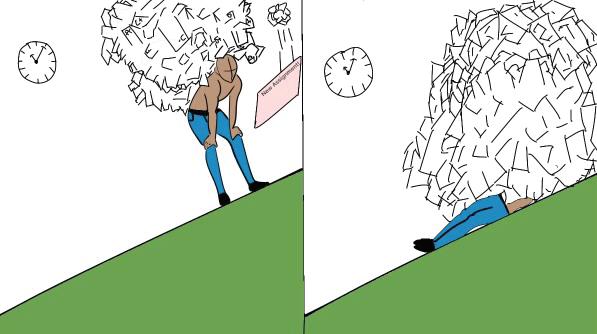
Though Canvas can be useful for keeping students’ assignments and schoolwork organized, it can also lead to an overdependence on the digital setup, US English Teacher Akemi Ueda said.
“Students are really reliant on Canvas, and if there’s something that isn’t on there – let’s say you said it in class – then kids will often just not have done it.”
Malik Shadid ’28 believes digital scholastic tools can cause stress, even for smaller assignments.
“I do feel more anxious when tests are given back, but sometimes
I’m just nervous to open smaller assignments because I don’t want to get a bad grade,” he said.
Reviewing assessments in person is better than viewing scores online, Malik said.
“If I was ever to get a C and had to wait until the next day to see my errors, that would be the worst feeling ever, so sometimes, I put off checking my grades so it doesn’t ruin my mood.”
Christian Chow ’28 finds the digital notification systems helpful.
“It gives you a good sense of where you are with your grades,” he
Scarlett Hawkins Features Editor
Music and conversations filled the air as South Asian families gathered in the Upper School (US) Community Room for Knight of Lights, an event celebrating Diwali, the festival of lights. Moving in sync, three smiling Lower School students took center stage for a traditional dance — one of the three student-led performances.
2500 years ago, the return of Lord Rama after defeating the demon king Ravana marked a defining moment in Hinduism — the triumphant victory of good over evil. Today, much of South Asia celebrates Diwali, the Hindu festival of lights, with family gatherings, fireworks, oil lamps and garba — a traditional dance.
At the annual Knight of Lights Diwali event on Oct. 24, 150 US students and parents gathered for classical dancing, henna and food. The South Asian Student Association (SASA) and South Asian Parent Association (SAPA) organized the event.
SAPA Co-Chairs Gargi Chakrabarty P ’29 and Anubha Sacheti P ’26 ’29 began planning the event in April.
“Diwali symbolizes the triumph of good over evil, light over darkness and knowledge over ignorance, which are universal values, and that’s why it’s such a defining festival for South Asia,” Ms. Chakrabarty said.
Knight of Lights was open to all community members.
“At BB&N, Diwali has become a vibrant tradition that values unity and community,” Ms. Chakrabarty said.
“Each year, Knight of Lights offers a moment of shared experience and collective celebration that bridges backgrounds, generations and perspectives. All the families come together through the common thread of food, performance and dance.”
Ms. Sacheti said the event enabled Hindu families to share their culture.
“Dances lead up to the festival
called garba, and everyone starts celebrating. It’s a time to showcase your closet and sashes, a time to get decked out in your culture. There are also so many cool dances that are fun and engaging, and it’s such a great way to expose people to our culture.”
The school’s willingness to showcase different traditions is key.
“I grew up in a place where there weren’t a lot of Indians, and I felt like I was caught between two worlds,” Ms. Sacheti said. “Amazingly, BB&N shares both of those places in one big identity, and they find pride in differ-

said. “I check my email every day because that’s how I know when teachers are returning assignments. And I can use my calendar to see what assignments I have to do.”
Christian said he doesn’t see an association between the digital system and stress.
“It’s not really about Canvas itself but more about the actual assignment. If you just took a stressful test, you’re gonna be stressed out about your grade. Canvas is just what delivers the message.”
ent cultures. It creates a bond with your school community.”
SASA Co-President Ayana Karthik ’26 welcomed attendees to Knight of Lights.
“It’s a time to gather with family and friends, and especially living in America, it can feel different celebrating Diwali because you are more isolated from it, but I am really grateful for the tight-knit Indian community I have at BB&N and what the Knight of Lights provides us with,” she said.
Nikhil Govindaswamy ’29 performed the sitar — a traditional Indian instrument — at the event.
“When I joined BB&N in sixth grade, it was great to know that my school has this community where I can share my family traditions,” he said. “BB&N’s Knight of Lights has helped me better understand my roots through the food and performances. It has also helped me get closer to others within the BB&N community, including from SASA.”
Rishaan Chowdhury ’29 said joining SASA has shaped his sense of community.
“SASA is a good way for South Asian students to bond, especially at such a big school like BB&N. On a dayto-day basis, I don’t see a lot of kids that look like me in all of my classes, so it’s nice to come together at SASA and feel connected.”
Vivian Cain-Weingram Contributing Writer
Between September and November, Upper School (US) seniors crowd into spaces like the Community Room and Lindberg-Serries Theater with their lunches to meet admissions officers from colleges across the country and the world. These 30-minute-long informational sessions enable seniors to learn about schools they’re interested in and offer insight into the admissions process.
US College Counseling Office Manager Antoinette Truman coordinated the college visits, which occurred every day except Wednesdays.
“Getting that face time with a rep can be really helpful,” she said. “They can see your face and your name, and they’re the same people that are reading your applications, … so when they see your application, they can connect it with you.”
Of the 112 colleges that visited, 37 were located in the Northeast and an additional 24 were from the East Coast.
University of Vermont Senior Associate Director of Undergraduate Admissions Kathleen Parent visited the US on Sept. 30.
“We use data like how many students are current applicants or how many past applicants have we received to make decisions on where we will travel,” she said.
During college visits, students can ask questions about anything from specific academic programs to campus life.
“I hope students walk away
“These sessions help students learn about a college they might not be able to visit or haven’t heard of before,” Ms. Truman said. “It’s a good opportunity for students to find out more about a school and broaden their horizons. Coming in with an open mind and being engaged and active in conversations is really helpful.”
with their questions answered, not only about UVM but the admissions process,” she said. “I always hope that I’ve eased some worry, as I know this can be a stressful process for students.”
Lexi Nicholas ’26 attended one college visit.
“It was really interesting to see an admissions officer faceto-face,” she said. “It made the application experience feel a lot more human.”
Meeting college representatives can be comforting.
“The admissions officer had a bubbly personality, and she was really sweet,” Lexi said. “It made me want to go to her school more. It gives me reassurance to hear admissions officers talk about how they do the application process.”

Extra time, not extra credit Testing accommodations increase by 46% over 3 years
Mimi Shaywitz On Campus Editor
This year, 21.5% of Upper School (US) students are approved for testing accommodations, a 46% increase from the 2022-23 academic year. US Learning Specialist Cayes Jarda attributes this change to improved tracking and commitment to supporting diverse learners. Students receive support from the US Academic Center if diagnosed with medical conditions that create a learning barrier.
Mx. Jarda and Middle School and US Academic Support Specialist Michael Cadman run the Academic Center. The Academic Center staff work one-on-one with students, host exam prep and drop-in sessions and facilitate a peer tutoring program. They also provide teachers with a learning profile on Veracross that describes a student’s accommodations and how best to support them.
Mx. Jarda said support for neurodiverse students isn’t “one size fits all.”
“The big difference between BB&N and public schools is we don’t modify our programs for kids,” Mx. Jarda said. “Instead, we will accommodate them. We work with students who have all sorts of learning needs and medical needs, too: anything from support with their teachers to support with accessing the curriculum.”
Students go through a tailored approval process before being granted accommodations.
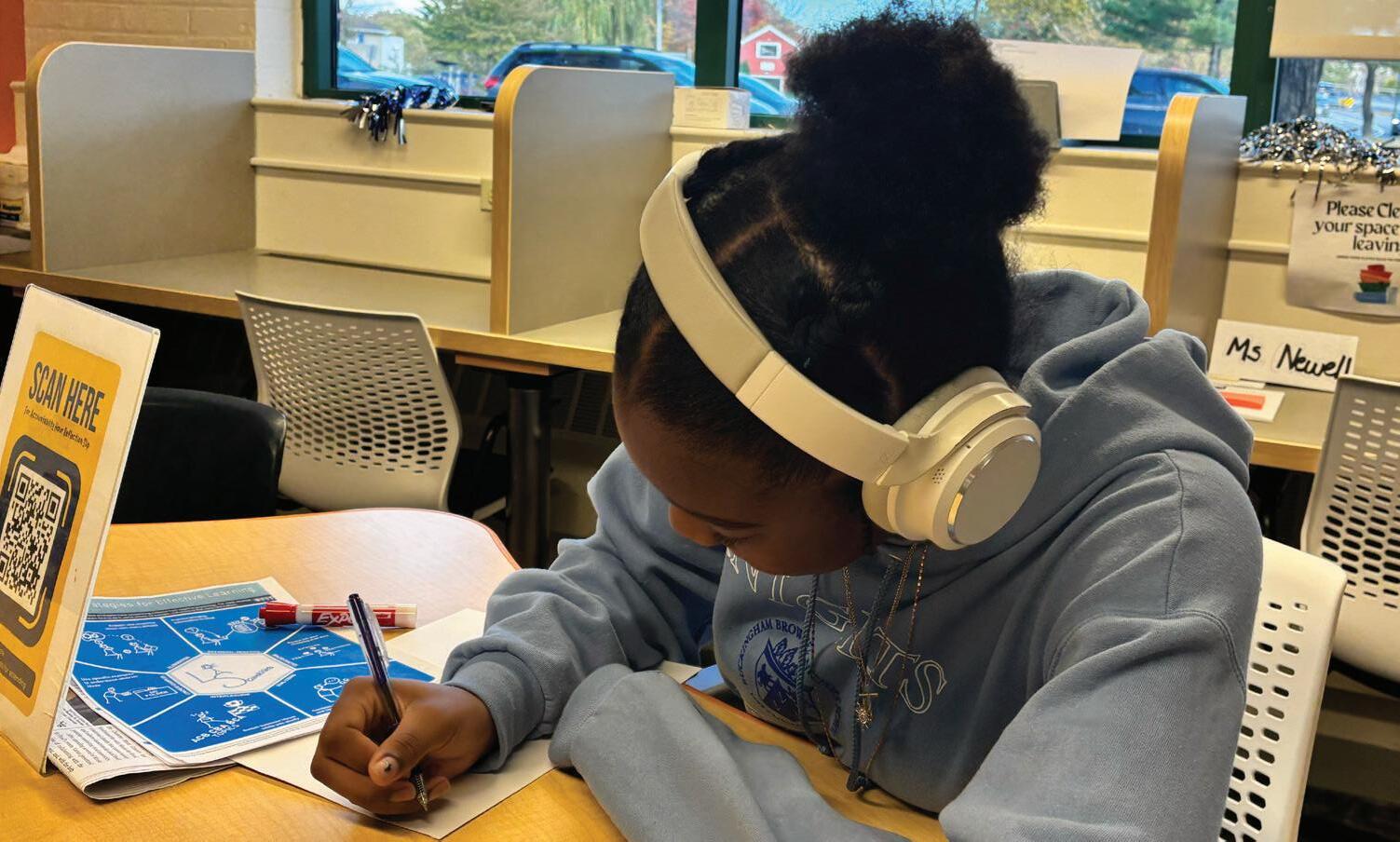
“There isn’t a singular list of approved diagnoses that automatically qualifies a student for accommodations,” Mx. Jarda said. “We consider any well-documented medical, psychological or neurodevelopmental diagnosis that significantly impacts a student’s ability to access the curriculum. Once we go through how that’s affecting the student, we come up with a plan with the evaluator, parents and ourselves and see what we can provide them.”
Extended time is often misunderstood, Mx. Jarda said.
“What I hope I’m doing is trying to demystify accommodations and help people see that it’s not an extra advantage. If anything, neurodiverse students have an extra hurdle to jump over. Extra time is not going to suddenly make someone a straight-A student. So,
Salar Sekhavat ’26 went to four informational sessions.
“I had actually decided I wasn’t going to apply to one school, but after I heard the college admissions officers speak about it with such joy, and I heard them talk about all the opportunities offered, … I decided I was going to apply,” he said.
Listening to admissions officers can influence which colleges students apply to, Salar said.
“At one of the college visits, the admissions officer was just so nice, and she seemed so invested in the students and their experience. She was talking about students she had met years ago who had gone and had so much fun at their college. It just felt really genuine.”
Fifteen international colleges traveled to the US, the furthest being New York University Abu Dhabi in United Arab Emirates.
“It’s a pretty incredible opportunity that these people are coming all the way to BB&N to talk to us,” Salar said. “These visits are super enlightening and eye-opening. Students should make the most of this chance to learn more about schools they may or may not be considering.”
it’s interesting when people get ruffled feathers about it or call it a boost.”
Students have to learn to selfadvocate, Mx. Jarda said.
“Kids who have accommodations here, we expect them to be responsible and communicate with their teachers and make sure that they have what they need.”
Quinn Reynolds ’27 has extra time accommodations for dyslexia.
“I have other accommodations, but I don’t use them,” she said. “I don’t know if it would be a longer conversation if I asked to use them. Because a lot of kids have extra time, a lot of teachers are pretty understanding. I’ve never had someone say, ‘No, you can’t use it.’”
Extra time accommodations can be difficult to schedule.
“I miss a lot of free blocks, and sometimes I miss lunch, but I’d rather have that than not have my extra time,” Quinn said. “I would probably not finish a single assessment if I didn’t have it, so it’s worth it.”
Quinn has seen the number of students with accommodations increase.
“I don’t know if anybody else had dyslexia, or people just didn’t speak about it, but I felt like I was the only one, and now I feel like everyone has an accommodation,” she said. “I feel like more people do than don’t.”
Ella Harlev ’27 has noticed the same trend.
“The increase may be because, as you get older, more factors can play into test-taking, such as test anxiety,” she said. “When you’re a high school student, it’s easier to be in touch with things such as anxiety, which may produce an increase in students needing extra time.”
US History Teacher Scott Tang said the education industry has increasingly addressed neurodiversity.
“As a teacher, accommodations are things that I’ve dealt with, but as a student when I was younger, these are not things I knew anything about. I appreciate how the teachers and the school are trying to look out for each individual student, trying to see what they’re capable of doing and creating opportunities for them to show what they can do.”
CONTINUED FROM PAGE 1

Fall sports media manager Armando Levitt ’27 promoted Homecoming via social media.
“Social media opens a lot of eyes and hopefully shows the students who decided not to go to those games that BB&N is the place to be,” he said. “They’re really entertaining and enjoyable. As a community, if we stand up and show out for our classmates, we’ll see a really positive influence there. Social media is a big factor that can inspire kids to show up to more games in the future.”
US History Teacher Jessica Stokes went to four of the seven Homecoming games.
“Being willing to show school spirit is an improving area for BB&N,” she said. “We’re learning how to do that better as a group. It’s really good to see so many people out at the events I went to, and that’s the place to start.”
Students and families showed up to support US teams, Ms. Stokes said. “I felt like the energy was even higher this year than in past years. Maybe it was because of the social media presence. It definitely helps generate energy, spread information about when and where the events are, and it’s fun when you see somebody’s picture who you know.”
Homecoming appealed to all three campuses, Ms. Stokes said.
“It was fun to see how families with kids, especially young kids, got to get in on the action for Homecoming. The bouncy house is a good addition and a way to make the event accessible to B through 12 and to get Lower School students excited about the opportunity to play in those games when they get older.”

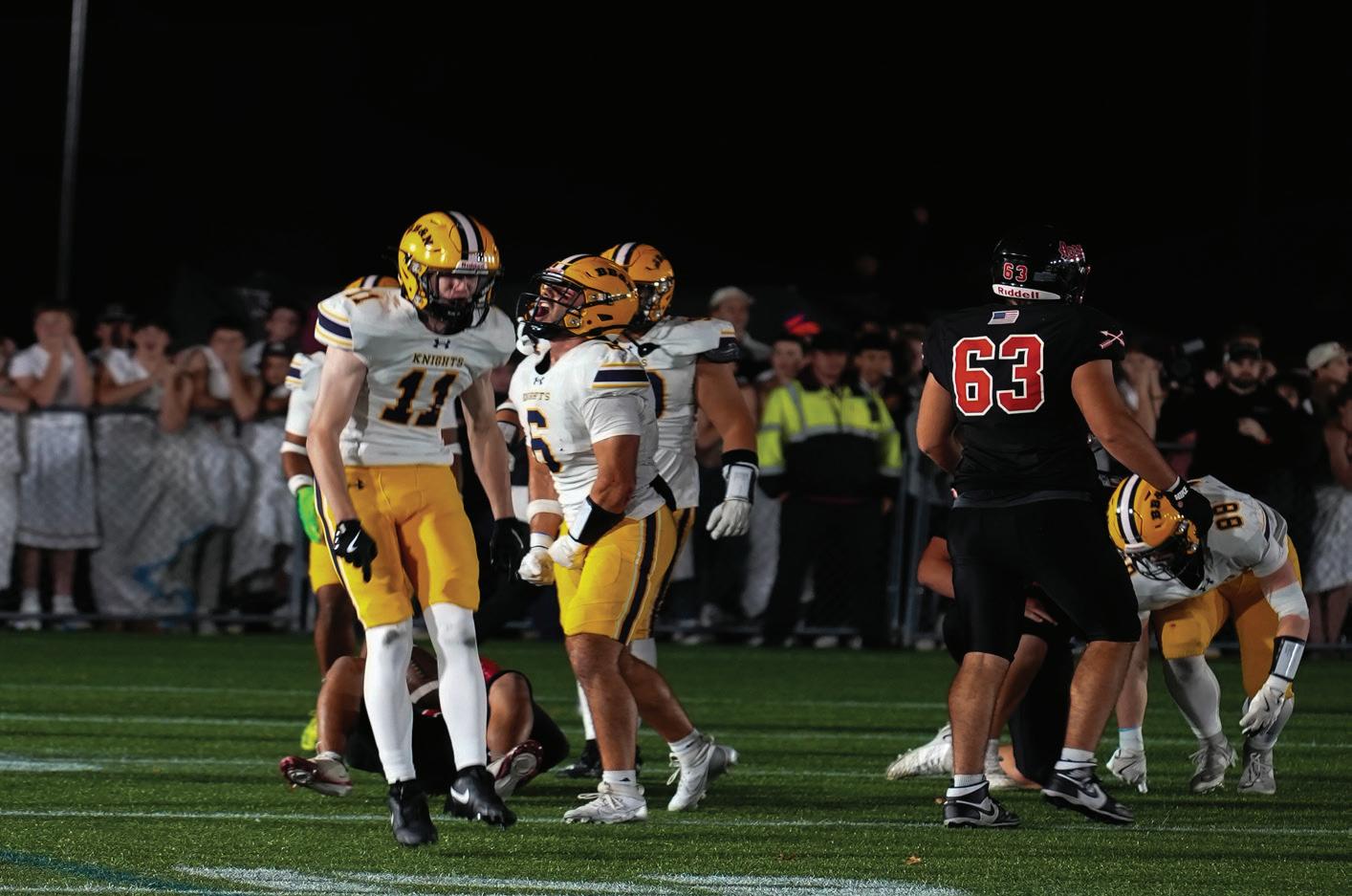





39 yards to victory
Everyone watched in silence, eyes fixed on the 39-yard field goal attempt. On the opposite side of Berylson Field, Milton fans roared, trying to rattle Varsity Football (VFB) kicker Vince Snoonian ’26.
With two seconds left, and VFB trailing 22-21, Vince’s kick soared in the air and cleared the uprights. Students rushed onto the field to celebrate the 24-22 win.
“It’s a community event where lots of people come out and have a lot of fun while supporting our team,” Head VFB Coach Mike Willey said. “Our team works really hard for this game every year, and we always hope to put out a good product.”
Coach Willey said the revised Homecoming schedule encouraged greater turnout.
“I love how the Athletics Department’s doing it this year, where they’re lining games up and spreading them out, some on Friday, some on Saturday, and they’re at different times. For example, we’ll be at the volleyball game on Friday and cheering them on. Then, we will get out to the night games. We like to get out to games, too!”
Fall sports media manager Armando Levitt ’27 wished more students had shown up for the football game.
“Regarding the entertainment of the game, it was phenomenal,” he said. “Considering the atmosphere, BB&N did a good job of offering a lot of different options, like merch and a food truck. The students did not show up the way they should have, and the student section itself was quite empty. Milton actually had way more supporters than we did in their student section, which was embarrassing.”

The Head of the Charles (HOCR) attracts between 300,000 and 400,000 spectators each year, and its five-kilometer course runs past the Upper School boathouse. The school raced four boats — Women’s Alumni 8, Women’s U17 Four, Women’s Youth Four and Men’s Youth Four — on Oct. 19.
Will Sammons ’27 coxed the Men’s boat with You-Yan Wang, Matthew Walsh, Lukas Wellesley (all ’26) and Quinn Conine ’27.
The team needed Quinn — originally an alternate — when another team member couldn’t race.
“We had an injury pretty early on in the season,” Quinn said. “So, it wasn’t a crazy thing, but it was definitely surprising because at the start of the season, I thought there was no way, like a 0.0 percent chance, that I would be in the boat.”
HOCR attendees brought high energy, Will said.
“It’s a pretty big deal because there’s so much going on, and it’s electric on the bridges, especially. There’s a lot of team spirit at the boathouse. I’ve been to the boathouse in years past for the Head of the Charles, and it was lively over there, and that’s what Homecoming’s all about.”
Elizabeth Velander ’26 raced in the Women’s Youth Four.
“The school social media has definitely been doing a good job of promoting the race,” she said. “They post the days coming up to a race on our Instagram and on the crew team’s accounts with videos and photos of us and try to get people excited. Because of it, a lot of my friends came to cheer me on. As you row past our boathouse, you can hear the volume increase. People get very passionate about being there, which is amazing to see.”


Pilar Bowen-Arce Staff Writer
Languages mix in the hallways and at home. Words get jumbled up on the page. Upper School (US) students switch between languages frequently without thinking twice. 136 US students are bilingual or multilingual, shaping how they communicate with others and learn at the US.
US World Languages Department Head James Sennette speaks English and French.
“There is a point when things start to get jumbled in your head, but with practice, that can get better,” he said. “Students who are bilingual have an upper hand in being able to make those connections because they know what it’s like to learn a language. There are many studies that say being bilingual enhances your intelligence because it works different parts of your brain that those who aren’t bilingual can’t access.”
Born in Brazil, Gabe De Oliveira ’28 grew up speaking Portuguese.
“Something I’ve learned is when you live in a country you are not born in but live so much in that language, you begin to forget your mother language and shift your life into English, into the language you are in right now,” he said. “So, I’m more domi-

nant in English than in Portuguese in some categories.”
Gabe learned English after moving to the United States in 2020.
“At BB&N, especially in the writing department, every time that I would have trouble with grammar, the teacher would say, ‘Well, English is your second language, so it is understandable that you would make a mistake,’” he said. “‘Therefore, I’m not going to grade you as severely in
grammar.’ They’re very understanding that I’ve only been here for five years. BB&N has a lot more opportunities and is overall a more liberating place to be yourself.”
Lauyanne Kouame ’26 lived in France for eight years.
“For math and STEM, it doesn’t really matter because there are mostly numbers, but sometimes, in English class or when I get a really hard text, it’s harder to understand because I try
What does it mean to be a Boston teen? US students discuss experiences shaped by living near
What makes Boston unique?

to translate it in my brain to see what it’s saying and to understand it,” she said. “I’ve learned to be more careful in my reading and pay more attention to certain words.”
Being bilingual can be helpful when learning new languages.
“I take Latin now, and that’s been helping because French and Latin are basically the same thing, so it helps me know vocab more,” Lauyanne said. “Knowing another language helps me a lot because English I learned by being here, but with Latin, you have to learn conjugations and tenses, and that’s similar to how French is taught.”
For Jone Abadie ’28, speaking Spanish has affected her acquisition of French skills.
“There’s similarities because they both have the same language root, so it can sometimes help me, but it can also be confusing because there’s some overlap, and you don’t know what overlaps and what doesn’t,” she said. “The US has a lot of language options, so if you already speak a language, it is easier.”
Jone said the US could do more to support bilingual students.
“One thing BB&N has been trying to do more is making these classes for students who already speak a language but don’t really know the grammar and writing that well. The expansion of that project could be really cool.”
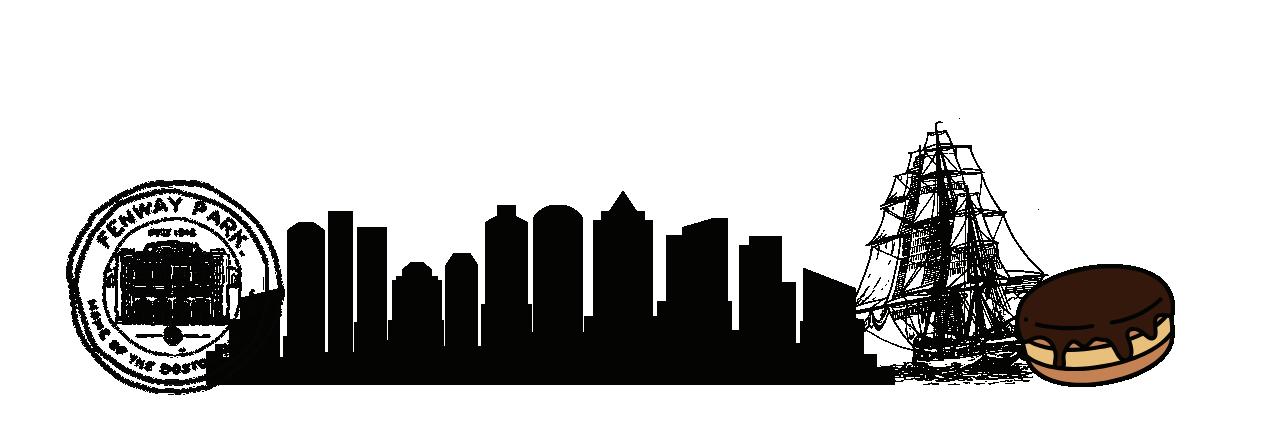
Boston is a city of polar opposites depending on where you are. It can have a very bustling working environment in one place, a very rich gentrified neighborhood in another place and then a lower income neighborhood somewhere else. The city has multiple identities at the same time, and you can’t just label it with one thing. What are the biggest benefits of living in Boston? Boston has taught me a lot about living skills, using public transportation, navigating a city and things like that. It has also helped me develop awareness. You always have to be focused when you’re in the city.
What are the biggest benefits of living near Boston? I like the suburban life. It’s not too busy, but you’re also not far from everyone and there are still things happening around the area. Boston’s very busy compared to Newton, so I feel less at home there, but it’s a place where I can have fun.
How has Boston’s status as a major tech hub affected how you think about your future? I find biotech and tech pretty interesting, and the opportunities available around here have inspired me to aspire toward that field.


How has the diverse and multicultural environment affected your experience? It’s definitely made it a lot more welcoming and educational in terms of the cultural experience. I have seen cultural events often take place in Boston, and you subconsciously get educated through all these different experiences. What is it like to grow up near Boston?
It’s very convenient because there’s a lot to do around here. Living around Boston, you’re not subjected to all the traffic and business of a city, but you still get the perks of having access to it. It’s the best of both worlds.
Viena Desai ’26
What is the social life like?

I live in the South End, and there are so many great restaurants there, so I like going out to dinner with friends, trying new places with different cuisines and getting recommendations from others. Boston in the fall is really beautiful, so I also enjoy walking around the city. There are so many things to do. How has the diverse and multicultural environment affected your experience? I keep an open mind because, in Boston, there are different foods to try, music to listen to and art styles to see. I’ve gotten to enjoy all those perspectives and cultures, and that’s something that’s really special.


“The sea mirrors the rising moon bright; miles apart, our hearts shared tonight,” ancient Chinese poet JiuLing Zhang wrote of the Mid-Autumn Festival, a time for Chinese people to reunite with family members and enjoy the full moon. Aligning with the fall harvest, the festival dates back to the Shang Dynasty over 3,000 years ago. Chinese families celebrated the Oct. 6 holiday with sweet mooncakes, symbolizing unity. —James Tao ’29

“There’s a reason we celebrate these thousands-of-years-old celebrations, and it’s because they’re really important. Through educating people, through inviting people to experience the joy, people can relate to and benefit more from it.” —Leah Cooper ’28



“It’s always been a special moment to celebrate with family. Even though my grandparents live in China, it’s a time to reconnect with them. Over there, in China, they’ve got the whole family together. My grandmother has seven siblings, and they all get together to celebrate.”
—Asian American Student Association (AASA) CoPresident You-Yan Wang ’26






Yancheng Zhao Managing Editor
Harvard Square-goers will notice something different as they visit the popular local attraction: There is no longer a Starbucks.
In a Sept. 25 statement, Starbucks Chairman and CEO Brian Niccol announced hundreds of nationwide store closures and the elimination of approximately 900 non-retail employees as part of his “Back to Starbucks” strategy from when he first took on the CEO position.
The coffee shop at 1 JFK St., which had replaced the world’s only Curious George store in 2022, was one of the closures.
“Our goal is for every coffeehouse to deliver a warm and welcoming space with a great atmosphere and a seat for every occasion,” he wrote.
As part of the plan, Starbucks reviewed its North America locations.
“We identified coffeehouses where we’re unable to create the physical environment our customers and partners expect or where we don’t see a path to financial performance, and these locations will be closed,” Mr. Niccol wrote.
In addition to the one in Harvard Square, around 20 stores in the Greater Boston area have also closed. The closures have shaken up students’ routines.
“When I don’t take the school bus, I take the train, so it’s really easy for me to hop over to Starbucks in Harvard Square and grab coffee,” Lucia Abraham ’28 said.
Now that she can no longer go

to Starbucks in person, she relies on delivery apps to get her drinks.
“I DoorDash before school,” Lucia said. “I get here early, so I drink coffee every morning. It’s inconvenient, and there isn’t really one close, so it adds time to my morning. I have been drinking less coffee, which is probably good for me.”
Lucia has switched to other coffee shops.
“I’m an avid Starbucks user and drinker, but I sometimes go to Dunkin’. I’m definitely drinking
“The difficulty for the Mid-Autumn Festival is a lot of AASA is not just Chinese, so we need to make sure everyone feels comfortable and embraced. The conversation should not only be focused around a festival for Chinese people because, if you’re Korean, you wouldn’t want the whole time for us to be talking about a festival that’s for Chinese people. That’s why it’s important to include everyone in it.”


—AASA Co-President Mirabel Ge ’27



more Dunkin’ than I was before.”
For Charlotte Rubins ’26, the closure of the Starbucks store by her house has been inconvenient, she said.
“I’m home alone a lot in the mornings, and I make my own coffee, but sometimes, if I just want to get a nice little pumpkin spice chai or something other than coffee, it gets a little annoying.”
Before, she could make a short seven-minute journey to her nearby Starbucks to pick up food and
drinks. Now, the closest Starbucks takes about double the time, Charlotte said.
“If I didn’t have time to make food or anything in the mornings, I could just go down the street. I used to be able to go in the rain or cold because it’s so close to my house.”
Hannah Rosado ’26 stopped visiting Starbucks before the closures.
“I went every now and then,” she said. “It was nice to get a refresher before. If I had a free block, I’d go, or before hockey, but I wasn’t emotionally attached. My mom and I liked to go together.”
She started boycotting the coffee chain in April because of her political beliefs.
“That’s a tiny thing I can do. Evidently, if Starbucks is shutting down some of their less popular places, it’s doing something.”
When the store in Harvard Square closed, Hannah received 400 stars in Starbucks rewards.
“I forgot to delete my account when I started boycotting,” she said. “Then, one day, I got an email that said we’re shutting down the Starbucks in Harvard Square. At the bottom, it said you now have 400 reward stars. I don’t go there anymore. I can’t even use them anymore, so I think I’m just going to let them expire.”
Hannah said she and others at the school haven’t had trouble finding new spots for coffee.
“The people around me don’t really care about Starbucks at all. Anywhere there’s a Starbucks, there’s a Dunkin’ nearby, too.”
Dr. Glazer has observed some recurring challenges when students collaborate.
“Some people want to get the work done straight off, whereas others think, ‘I work best in the eleventh hour,’” she said. “That’s a skill, working with others, but it’s also one of the biggest challenges.”

Teachers can ensure students contribute equally to group projects.


“You can ask for individual work to be done, as well as group work,” Dr. Glazer said. “You can have students submit things so you can see their work. The teacher can divide up the project and say, ‘This is person A, B, C’s role.’ You can give work periods during school to find out who’s doing what.”
Caroline Rogers ’27 sees pros and cons to group work.
“Teachers often create nuanced rubrics that hold each group member accountable for their contribution,” she said. “A group project works well when partners are graded individually. When group projects don’t have enough structure, students can be

put in tricky situations. It should never be a student’s job to police others, but without enough structure in a grading rubric, students aren’t held accountable.”
Caroline has completed all the group work when other members didn’t contribute.
“Resentment can build on both sides,” she said. “The group members who are contributing more can feel like they are being used, and the members who are
contributing less can feel controlled. Handling these situations can be difficult because social dynamics often make it hard to advocate for yourself.”
Kate Glantz ’27 has learned from her peers through group work.
“It’s easier to get everything done when you have people to explain things you might not understand,” she said. “Sometimes, in chemistry labs, I would be con-
They’re just ‘spokes in the wheel’ US upperclassmen say SAT, ACT don’t tell full story
For many Upper School (US) upperclassmen, the SAT and ACT are sore subjects to bring up, looming as a source of comparison and pressure. From long study sessions to the expectation of high scores, students face an intense testing culture — even as 2,089 colleges across the country have become test-optional.
US College Counselor Fred Coyne used a metaphor to describe the significance of standardized testing results.
“A bicycle has spokes,” he said. “If you take one spoke out, the wheel still turns. I want students to view testing as just one ingredient in their college application. I’ve had kids apply to the most selective colleges with perfect scores and not get in. That proves it’s not one ingredient that tips the scale. Colleges care deeply about how you’re doing in your classes, what kind of student you are and your essays.”
Almost every sophomore and junior took the Oct. 15 PSAT, a practice for the SAT. US students often begin preparing for standardized testing during their junior year with around 80% taking the SAT.
Alex Tsay ’27 started preparing for the SAT over the summer heading into his junior year. He took the exam twice and plans to continue taking it.
“I didn’t want to drag it on
and stress about it, so I decided I’d study in the summer before junior year and try to be done with it as early as possible.”
Alex experienced external pressure while preparing.
“Everyone’s goal is 1500plus, and my parents expected it for me and my brother,” he said. “Most of the time, my parents didn’t bother me too much, which I am grateful for, though at times they had unrealistic
expectations, like, ‘You have to study for six-plus hours every day,’ which I didn’t do.”
While preparing, Alex used resources like Bluebook, the SAT testing platform; Princeton Review; Khan Academy and SAT prep books.
Finley Long ’26 took the SAT three times.
“The test scores don’t represent me as a student because it’s a small sample size,” he said.

fused on a question, and my partner would explain the concept to me and help me understand how to answer the question. In the past, I’ve answered some questions or completed parts of the lab, and my partner noticed I didn’t have everything in my answer that the question was asking for.”
Individual work has greater benefits, Kate said.
“There have been instances when people don’t complete things until the very last minute, leaving you to panic because, while it’s not your fault, you and your partners get the same grade. If it’s an individual assignment, it removes the stress of wondering about what the other people are doing and whether they will get the work done on time.”
Maggie Whitney ’28 has had mixed partnered work experiences.
“Sometimes, it’s great because everyone contributes, and we bounce ideas off each other, but other times, it’s frustrating when people don’t do their part or when the group isn’t organized,” she said. “A group project works well when communication is strong, roles are clear and everybody cares about the outcome.”
“What if I was just having a bad day and bombed the test? Is that who I am as a student?”
Understanding how the SAT works is key.
“Don’t worry about it until the summer before junior year at the earliest,” Finley said. “As long as you recognize patterns and know how to exploit the test, you will be fine. For example, there are specific types of questions, and their answers usually follow the same format.”
Competition added onto the stress Violet Zhang ’27 felt.
“Most of the comparison happens when I hear about other people’s test scores and start to self-sabotage,” she said. “I built this narrative that most kids don’t have to study hard and only have to take the SAT once before getting a target score.”
Amanda Berlin ’26 didn’t feel relieved by the rise of testoptional colleges.
“A lot of the time, the SAT’s about work ethic and perseverance,” she said. “I know a lot of people who can be great students, take it once and get it over with. I also know people who receive good scores but might not do very well in school. What colleges need to look for is: You know this knowledge before you step into the real world. All of the tested subjects are on grammar and things we should know, but not knowing doesn’t mean you’re not intelligent.”
On Oct. 18, millions across the U.S. took part in the No Kings protests, a nationwide movement opposing what many see as rising authoritarianism under President Donald Trump. Named after the American principle that no one should rule like a king, the protests focused on defending democracy, civil rights and free expression. In Massachusetts, thousands gathered in Boston Common for the state’s largest rally, and smaller demonstrations were held in other parts of the state.





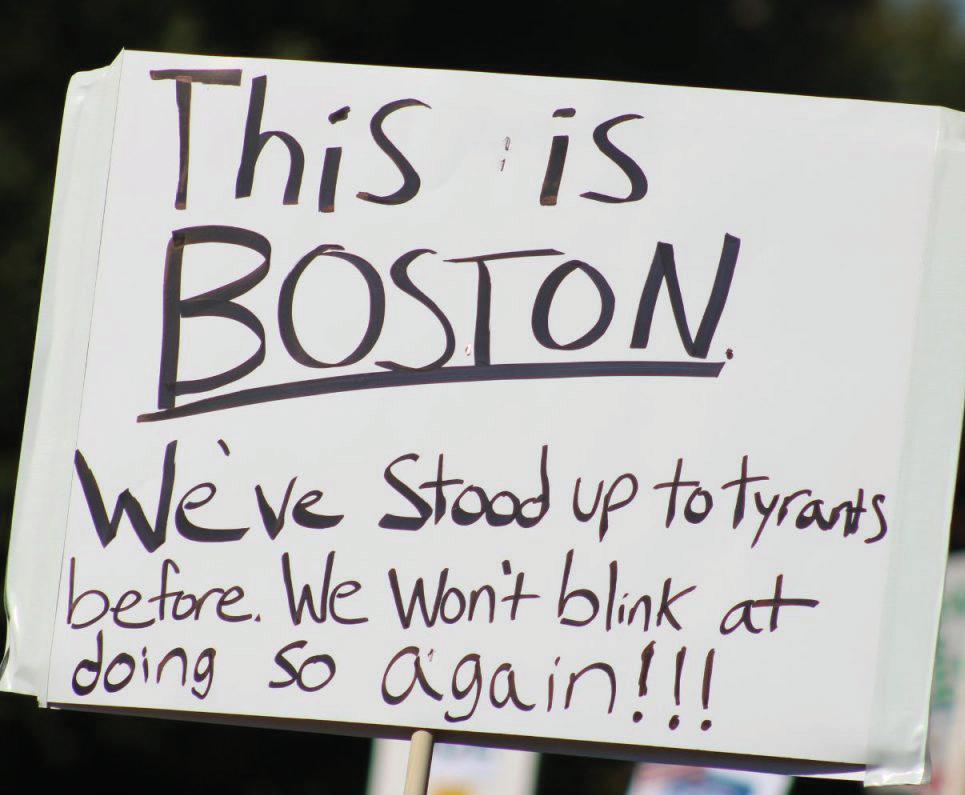








The Vanguard sat down with Adrian Resnick, Charlotte Garrity (both ’26), US Film Teacher Christopher Gaines, and US History Teacher Susan Glazer to discuss their participation in local protests.
Adrian: I’ve been seeing all the escalations that have been happening on social media and on the news, and it’s been freaking me out. I’ve been thinking a lot about it because I want to go to college in Missouri and that’s a more red state than Massachusetts. I was in Newton Center when it was happening with my girlfriend, and we were so inspired to go all of a sudden.
Mr. Gaines: I attended a No Kings protest in Salem, and what motivated me to go to the protest was wanting my kids to see there are many kind, giving people out there. I didn’t look at it as much as a protest but more as a moment of community and solidarity.
Adrian: There was this one speaker who was a normal social studies teacher at an elementary school. It was shocking how literally anyone could have a big impact and speak in front of this many people.
Mr. Gaines: I found it incredibly strangely emotional. The protesters lining the street got all the people in traffic, like regular people to honk. Seeing a man in a dump truck honk his horn in solidarity, there’s something very sweet about that connection with people that felt really good.
Charlotte: The attorney general was there, and she was talking about Boston fighting against monarchy ever since it was created. I really liked her emphasis on Boston being one of the first places to support democracy, and it felt pretty special to be there when she was talking about that.
Adrian: Deportation. My mom’s an immigrant, and that really put it into perspective for me that this could literally happen with anyone. There was this woman who was 53 and came to the U.S. two years earlier than my mom, and she was all over the news. She was just going to buy ingredients for soup, and she got taken by ICE even though she’s been living here for 20-plus years. My mom is a citizen, but if she hadn’t gone through that process, that could be her, which was a really sobering moment.
Adrian: Schools should support people engaging in their beliefs on either side of the aisle. This shouldn’t be taboo to talk about. Schools encouraging people to talk openly is the best way to resolve our problems because if people keep shutting themselves out and saying that it’s such a taboo thing to speak about, then we’re never going to get progression.
Dr. Glazer: There are a lot of ways other than voting for young people to get involved. It’s not just protests you can take part in. There’s letter writing, there’s organizing campaigns. Your superpowers are bringing the energy, using social media, sharing out, being passionate about certain topics.







Interview with The Vanguard’s music “expert” Ryan Clay on concert culture:
Based on your experience, what makes a a good concert?
The two things I took away from The Lumineers and Childish Gambino are they did more than just perform music. At The Lumineers, their pianist is this crazy dude who wears a red tuxedo with no shirt underneath it, and at certain points, he’s shirtless during the concert. Sometimes, he’ll play the piano with his toes. Childish Gambino had a laser show that was way more insane than I had expected.
How do you feel about ticket–reselling culture?
It’s an unavoidable problem to have. It sucks that they’re so expensive, but at the same time, music is more accessible than it has ever been. I guess you could set a price limit on resale tickets, but I don’t know if it’s that much of a moral dilemma.
What are your favorite concerts you’ve been to?
Out of the concerts I have been to, Childish Gambino was definitely my favorite. It was an ethereal experience. It was the first concert I went to as a teenager. There was also The Lumineers, which was awesome because it was at Fenway, and there was a beautiful sunset.
Why do you listen to music?
I use music for pretty much everything, and that’s why it plays such a huge role in my life because it can serve any purpose. It’s so useful in every part of my life, whether that be in hockey or jazz band.
How do you feel about people being in the moment versus recording or taking pictures at concerts?
It’s stupid that everyone has their phone out. At Childish Gambino or The Lumineers, I took a couple photos, but my memory lives on much more in my head than it does in those photos. If I had taken a video of the entire concert, it would have taken away from my own experience. Just sit there, enjoy it and tell your friends







To remember times in my life. If I listen to something all summer, that song will always remind me of that summer.
–Teacher
To drown out the relentless inanity of life. –Teacher
Survey Responses: Why do you listen to music?
To amplify my emotions: to either calm me down more, let out a good cry or get really excited for something. –12th grader
When I was a teenager, music helped me to understand feelings that I did not yet have the words to express. This is still true to some extent, but now, music is also a way to connect with other people, relax and have fun. –Teacher

63.29% of people think that sound matters more than lyrics in songs
To filter out distracting thoughts or ideas that are making my work more difficult. –9th grader
To clear my mind and release stress. To dance and have fun. –Teacher
Less than 6% of people spend more than $500 on concert tickets
The Upper School listens to 1,792 hours of music a week (that’s 256 hours of music each day!)

86.31% of people spend up to $300 on concert tickets
If you could share one song with the world that represents how you see life right now, what would it be?
“The Long and Winding Road” by The Beatles. I believe that the road represents life, and the song talks a lot about the unattainable. I feel like people are looking for something more and trying to reach a destination, and it causes life to be a constant pursuit. No matter the twists and turns of the pursuit, people will always pursue along the path of life. –12th grader
“TV” by Billie Eilish: It represents how much stuff is going on in the world and how hard it is to keep track of it. –9th grader
Pink Floyd’s album “The Wall” changed my view on the value of working through your feelings instead of “walling” yourself off. –12th grader
Definitely. Songs like Bad Bunny’s DTMF (DeBÍ TiRAR MáS FOToS) have really made me recognize and reconsider the importance of documenting the present and past because, after the day is done, who knows what will still remain of yesterday. –Teacher
“Vienna” by Billy Joel because it’s a metaphor for taking time to enjoy life, slow down and not rush through your younger years trying to achieve everything at once. I feel like this is really fitting for my senior year and trying to stay present in my life. –12th grader

“This is America” by Childish Gambino is one of the most powerful music poems/video essays of the 21st century. –Teacher Has music ever changed your perspective on something?




After school, many Upper School students stroll through the streets of Cambridge and Harvard Square while ordering food, browsing stores and hanging out with friends. Several of these local businesses are owned by families whose children attend the school. The Vanguard spoke with the owners of Hi-Rise Bread Company, Lovestruck Books and Amelia’s Trattoria, Sulmona and Mex to hear their experiences of running a family business. —Lucia Longstreet-Lipson ’27

The scent of freshly-baked pastries drifts through the air, and the hum of conversation buzzes as sunlight spills across the tables at HiRise Bread Company, a cozy Cambridge café. Rene and Cynthia Becker (P ’29) own the bakery that’s approaching its 30-year anniversary.
Known for its fresh breads, pastries, sandwiches and coffee, Hi-Rise reflects Mr. Becker’s experiences and philosophy.
Mr. Becker started baking bread in college after his friends opened a deli.
“When I started Hi-Rise, I did not want it to be a factory,” he said. “I wanted to be a part of a neighborhood, a place where people would meet. It’s amazing how many people have met over the years at Hi-Rise, so many neighbors connecting with neighbors for the first time. It’s a wonderful feeling.”
Mr. Becker’s daughter, Lucie Becker ’29, is involved in the family business.
“It’s hard to balance work and family life, but fortunately, we live really close: right across the street from the bakery,” Mr. Becker said. “Our family is completely involved, even
if Lucie doesn’t have her hands on everything yet. She hears our discussions about what we want to do and how we can improve things, and she’ll be more involved as she gets older.”
Mrs. Becker said Hi-Rise serves as a gath ering place for the local community.
“One of our goals is to be a neighborhood bakery and to be a place where people in the community want to come and connect. When I had my daughter, Lucie, I got myself out of the house, and I’d go sit at Hi-Rise and meet other moms. We see BB&N families at the bak ery all the time, and we’ve met so many over the years. Now that we’re a BB&N family our selves, it’s nice to feel that connection to the neighborhood.”
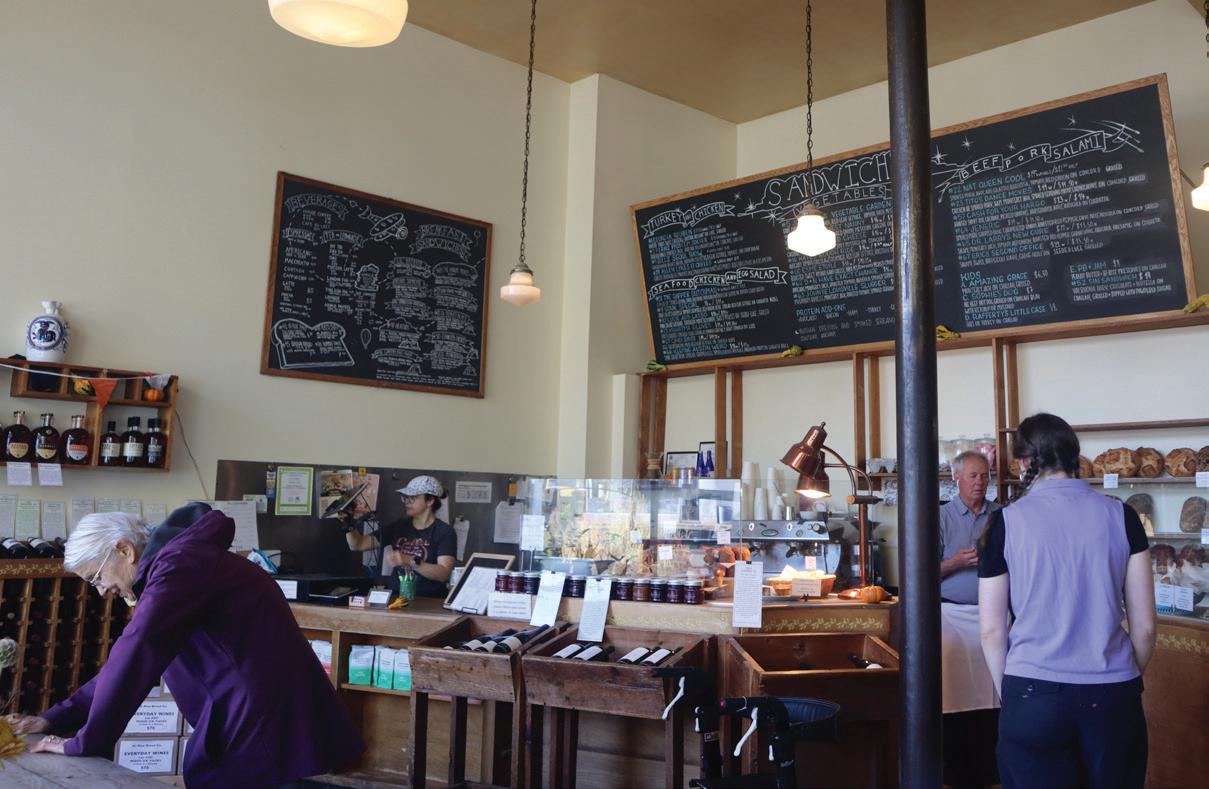
For Lucie, it’s been unique growing up around the bakery.
“My teachers are always there, and everyone talks about it,” she said. “I used to help out when I was younger, making espresso or helping with the bread, and I’ve learned a lot about how much work it takes to run a business.”

Opened in December 2024, Lovestruck Books and Coffee Shop is a romance-themed bookstore and café partnered with George Howell Coffee. It was founded by Rachel Kanter P ’36 ’38.
“When I asked myself where I would want to hang out, it was always a bookstore and a café,” she said. “It’s great because it helps people stay longer, and even if people don’t end up buying a book, they can still buy a coffee and support the business”
The bookstore’s romance theme creates the inviting atmosphere that keeps customers coming back.
“The romance theme really sets a cozy vibe in our bookstore and café,” Mrs. Kanter said. “Soft lighting, comfy seating and a bit of romantic décor make it a perfect spot for reading and hanging out. It adds an emotional touch, too. Romance books bring back sweet memories for
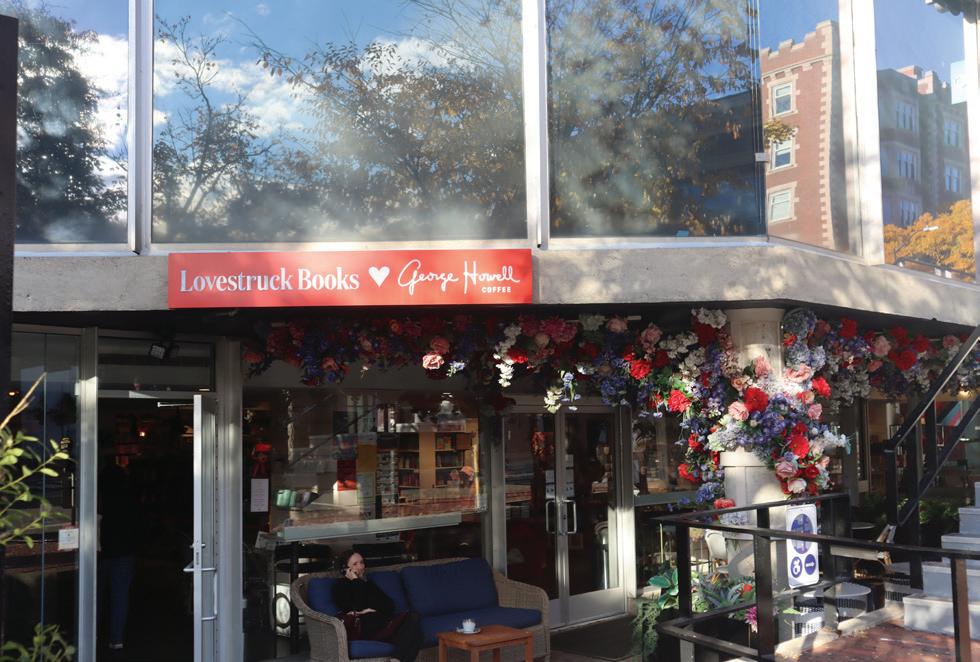

“Each of our restaurants is unique,” Rebecca Susi P ’26 ’30, who owns three local eateries with her husband, Delio, said. “Amelia’s and Sulmona are fashioned after my husband’s heritage. The smaller Italian one, Amelia’s, is named after his mom, who our daughter Amelia is named after, so it’s very personal to him. This larger Sulmona restaurant is named after the town that they are from in Italy.”
While the first two restaurants draw on family heritage, Mex reflects the cultures of the employees who work at the restaurant.
“The Mexican restaurant is inspired by our staff and the food that they like to cook in their culture, so he made that an homage to them,” Mrs. Susi said. “What differentiates us from the bigger corporations is we’re here every day, and we know our staff. They’re part of our family. It’s very hands-on.”



All three restaurants are located in or near
Kendall Square.


“Cambridge is a really cool community,” Mrs. Susi said. “Particularly in Kendall Square, which is surrounded by all the biotechs, Google, MIT and Harvard students, I’ve met some of the most fascinating, smartest people. It’s neat to be a part of that, and I feel we’re really lucky.”
School families and students often stop by the restaurants.
“When students or teammates will come and bring their friends, it makes me and my husband so happy,” Mrs. Susi said. “We’ve hosted some varsity banquets the past couple of years, and I love making the restaurant part of the kids’ lives. BB&N families also come and support us, which is great.”
Mrs. Susi hopes her kids, Amelia Susi ’26 and Jack Susi ’30, learn from the business.
“It’s important that my kids understand the service industry,” she said. “It’s a skill everybody should have, so they help out in some capacity. They’ve grown up in the restaurant and been here almost every day since they were born.”

people, making them feel right at home.” Cambridge offers support to local businesses through initiatives like the Small Business Enhancement Program and the Boosting Business Blocks Grant.
“It’s always hard for independent businesses to compete against the big corporations that can afford to price things lower,” Mrs. Kanter said. “We need to make sure we do something different that adds value to the community so people feel good about shopping with us. People were really excited to see a new family-owned business open in the Square because it reminded them of back when there were more of those.”
The school has hosted several events at Lovestruck, including a parents’ book club and the school book fair, she said.
“The community’s been great about finding ways to involve me as a business owner, which I really appreciate.”
For Amelia, the family business has been a defining part of her life.
“It’s shaped me as a person when it comes to my values and the things I work toward,” Amelia said. “I wrote my college essay about it. Sitting at the end of a barstool all my life and observing interactions with people has really helped me. It’s taught me about responsibility, problem-solving and social interactions.”

Every Veterans Day weekend, a variety of television stations broadcast old war movies; from a young age, I learned from my father the importance of these films.
My great-grandfather Henry and my great-granduncles Isadore and Raymond all fought in World War II. Raymond was the eldest, barely 24 when he enlisted just before Pearl Harbor, Isadore was 19 when the war began and Henry was a high school student. Isadore and Henry returned home safely; Raymond did not.
It became — and is — of solemn importance to watch these Veterans Day films to remember the courage of those who survived, and those who did not, and to hope for America’s future.
One of these Veterans Day weekend movies is the 1953 satire piece “Stalag 17,” which focuses on American POWs in a Nazi stalag (prison camp). Even facing atrocious situations, the American sergeants manage to laugh with each other and at the bumbling Krauts — the Nazis. What awes me no matter how many times I watch “Stalag 17” is the young American men’s bravery. Even at the hands of the Krauts, the sergeants never relinquished, exemplifying some of the characteristics we should try to embody and face the challenges in our own lives with, too.
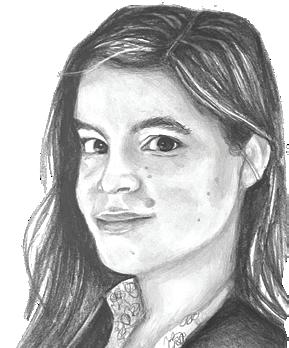
“Without these courageous boys, without the Tommys and Novaks, we wouldn’t have even a fraction of the prosperity and peace we enjoy today.”
Since I wrote my junior year research paper on my family members who fought in WWII, Christopher Nolan’s 2017 “Dunkirk” also holds significant meaning for me. Focusing on the May and June 1940 evacuation from Dunkirk after the Germans surrounded the Allies, “Dunkirk” follows Tommy, a young British soldier, and another soldier he meets on the Dunkirk beach (whom we’ll call Guillaume since we’re never told his real name). “Dunkirk” exemplifies heroism and justice in a different way than “Stalag 17.” Tommy is incredibly inexperienced — every time I watch him escaping across the English Channel, I remember that he and Guillaume are hardly older than me. They drop their belongings in the sand to save a wounded man. They shake at the sound and sight of the Luftwaffe. And yet, they are brave and just. Guillaume saves Tommy from drowning, and Tommy believes Guillaume is no Ally traitor even when a band of Scots accuses his friend of being a German.
Despite youth, inexperience and fear, they’ll fight side by side until the end, be it bitter or melancholy sweetness. In both films, the bravery of these young men is astounding. To fight against the Nazis and Japan, to hold out in the face of sometimes almost-guaranteed failure, to sacrifice and toil for the preservation of the free world is honorable beyond any means, yet people nowadays are content to villainize America.
My grandmother recently found Raymond’s posthumous Purple Heart. Opening that pristine, 80-year-old silk box and gazing upon the weighty violet ribbon and golden medal, wrapped perfectly in paper, all I can impart is without these courageous boys, without the Tommys and Novaks, we wouldn’t have even a fraction of the prosperity and peace we enjoy today.
Films preserve precious moments in time, especially these memories of bravery that I cherish. If you feel the same, maybe this Veterans Day, give “Stalag 17,” “Dunkirk,” “Patton,” “Saving Private Ryan” or “Band of Brothers” a watch. Or better yet, go out and learn about your own family history. Learn, remember, honor.

The most captivating records are those that not only offer a window into the artist’s mind but also immerse the listener in the artist’s experience. Frontto-back records that do this coherently across every track are becoming increasingly scarce; mainstream music artists seem to be bridging the space between hit melodies with “filler tracks.”
Abel Tesfaye, better known as The Weeknd, provides a perfect framework for captivating front-to-back albums for new artists with his 2011 debut record, “House of Balloons.” Across the nine songs, The Weeknd transports the listener into the drug-filled party lifestyle he experienced as a Toronto teen (the metaphorical “House of Balloons”).
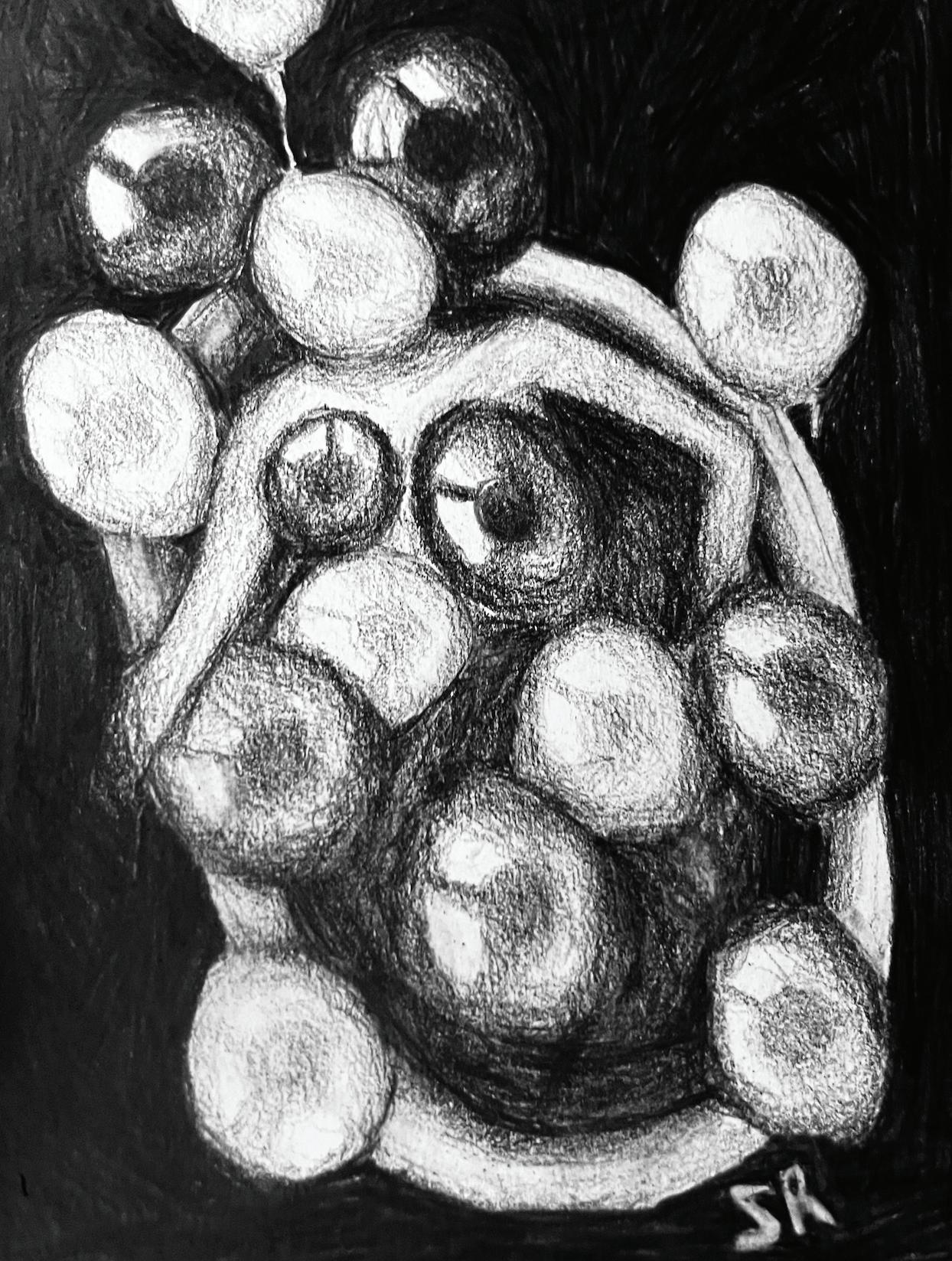
The album’s first track, “High for This,” is a stark recommendation for the next 48 minutes of music: Listeners might understand the album under the influence of drugs. It introduces the main sounds that distinguish the album: Echoey and subdued drums back the track, as if being heard from another room, and a boxy, crunchy synthesizer marks the highs of the track.
The Weeknd does exceptionally well contrasting messages and feelings between the two sides of the track. In “House of Balloons,” The Weeknd’s voice is pleading; his vocal inflections seem stressed: “Oh, this is a happy house / We are happy here / In this happy house.” He doesn’t believe the house party he is throwing is enjoyable and tries to convince himself — or the girl he’s with. The music communicates his drug-induced stress; an arpeggiating high synth plays minor chords that sound like an alarm. The Weeknd’s stress becomes the listener’s discomfort.
“The mood of this album is what sets it apart from other R&B albums. Everything about the album feels dark.”
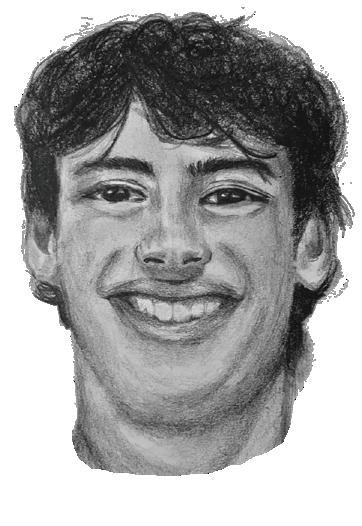
The second half of the track contrasts with the stressful first part. Behind a constant bass synthesizer (the same as in “High for This”), The Weeknd assumes a more laid-back demeanor. He raps the second part of the song, letting his smooth voice calm the listener, effectively placing us in the perspectives of both The Weeknd and the girl he brings to the party.
The mood of this album is what sets it apart from other R&B albums. Everything about the album feels dark. A creepy monochromatic album cover of what seems to be someone in a bathtub covered by balloons sets the stage for the album’s mystery. Additionally, complemented by dark, crunchy synthesizers, the record’s lyrics are all about taboo and profane subjects.
“House of Balloons” is an unparalleled record in the dark R&B genre. The Weeknd’s ability to draw the listener into anger-filled melodies marked by minor chords and moody synths is something that I haven’t found in any other corner of the music industry. Front to back, this album tells a coherent story and has a sound that’s so unique, it stands out as one of the best dark R&B albums of all time.


“Team-wise and culture-wise, every game and every practice is always super fun,” Varsity Field Hockey (VFH) Co-Captain Skylar Hartshorn said. “This is definitely my favorite team, whether we’re winning or not.”
Though VFH ended with a record of 1-11-2, the team beat Westminster School for the first time and tied with St. Mark’s — a team they previously lost to. Last year, VFH advanced to the New England Preparatory School Athletic Council (NEPSAC) Class A tournament.
Skylar received an All-NEPSAC honorable mention last season.
“Being a player with the rest of the team is most important, but being able to have that assigned leadership role also helps to integrate people into the team like freshmen, and that’s really rewarding,” she said. “It really adds to the supportive team dynamic.”
Ace Van Vliet ’27 has played on VFH for three years.
“We’re a team of gamers, and that’s why we’re not discouraged,” she said. “We don’t want to quit. The reason I keep coming back every year is because of the team. When I was a freshman and starting out in the sport two years ago, everyone was so welcoming and supportive. Who doesn’t want to be on a team like that?”
Ace has learned from her experiences on VFH.



“My teammates and coaches have taught me how to lead by example and demonstrate the effort you need to put into a team, especially for underclassmen,” she said. “I try to show what it means to go in every day, work hard for your goals and never let up even if you’re losing.”
Forming a ‘brotherhood’
Coming off an undefeated season and an Independent School League (ISL) Championship, Varsity Football (VFB) has kept its foot on the gas with a 5-1 record.
VFB Co-Captain Liam Cunningham ’27 attributes much of the team’s success to VFB Head Coach Mike Willey.
“I can’t say enough great things about him,” Liam said. “He’s a terrific person. He’s really helped me become a better man over my time playing for the Knights.”

Coach Willey’s lessons extend beyond the field, he said.
“One of our three main values as a team is accountability, and Coach Willey really preaches that. Everyone on the team is really accountable for something, whether it’s orchestrating a late-game fourth-quarter drive or it’s getting the pads or the waters out to practice.”
The football team participates in year-round offseason practices.
“That really sets us apart from the other teams,” Liam said. “We try to meet with each other as much as possible in the offseason so that we can be the best team that we possibly can. It’s really a brotherhood.”
Tight end and defensive end Colton Fischer ’28 agreed.
“We have really strong bonds on the team and really strong leadership. We all work well together and hold each other accountable. Everyone’s fit into where they need to be by now.”
—Noura Farahat ’28
Breaking records, building team culture
Having earned four consecutive Independent School League (ISL) Championships, Girls’ Varsity Soccer (GVS) sent five athletes to play Division I soccer in 2025.
GVS Co-Captain Aubrielle Amaral ’26 said GVS’s past success motivates the team.

“We put a lot of pressure on ourselves because of the winning history of the program and strive each game to continue its strong legacy. It is very competitive, and we are trying to win the ISL for the fifth year in a row.”
With six seniors leaving the team, new teammates have stepped up.
“We have a very young team with seven freshmen, and they have each grown a lot as they immersed themselves in the program and team culture,” Aubrielle said.
Morgane Massard ’28 said GVS players balance competition with team-building.
“The captains create a great dynamic on the team. They make it so that everyone’s focused in practice, but also we have fun things like team dinners, bonding and recovery where we all talk.”
With a final record of 7-2-2, GVS will compete in the NEPSAC playoffs in November. —Noura Farahat ’28
A line of Boys’ Varsity Cross Country (BVXC) runners awaited Scarlett Hawkins ’27 at the Oct. 18 Homecoming Race, cheering as she sped into the final stretch of the race, claiming first place. Scarlett’s win was a sign of things to come: Both the Girls’ Varsity Cross Country (GVXC) and BVXC teams swept Brooks, 15-50 — the best possible score. BVXC Co-Captain Diego Abadie ’26 also broke the school course record with a time of 16:38.
GVXC finished the regular season with a 7-4 record, and BVXC ended with a 7-6 record as both teams headed into the Nov. 8 Division II NEPSTA Championships.
BVXC Co-Captain Finley Long ’26 noticed a change in team spirit during mid-October.
“At St. Marks, we had a lot of team spirit and everyone was cheering,” he said. “At the beginning of the season, it was pretty silent. People would just run their route, but now, both teams are supporting each other. Those moments are the ones that really stick out to me, because when I’m running, I really appreciate when people are cheering for me, so I’m happy to see that everyone can feel that now.”
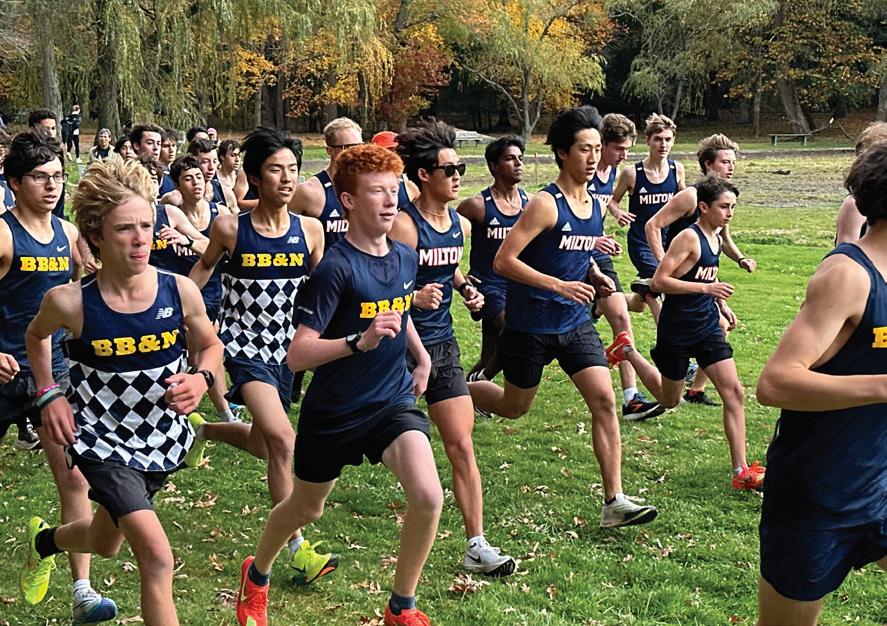
GVXC runner Griffin MacDonald ’28 said team bonding is a key part of being on GVXC and BVXC.
“Most people don’t know we have stuff like team dinners and workouts together. It’s not just running. After our last meet, we went to go get ice cream. Everything is great with the team, and I hope it continues.”
GVXC and BVXC Head Coach Charlie O’Rourke works with five other coaches to support the teams.
“Coach Charlie and the rest of our coaches are super motivating but also understanding,” Griffin said. “If you’re not feeling well, they’ll make sure you go to the trainers or rest. They don’t push you to do more when you are sick because they don’t want you to feel worse. Besides that, the workouts they have us do are really helpful, and they’re just super supportive all-around.” —Valor McGrath ’28
Robbie Lally and Syrah Gill Staff Writer and Contributing Writer
Under the lights of the football field, shoulder pads clash and coaches call out plays, but not every athlete in a Varsity Football (VFB) jersey is from the Upper School (US). This fall, four eighth-grade students — Darin Shaw, Ben Silverman, Will Kelly and Michael Noonan (all ’30) — have earned spots on the roster and taken the field alongside older teammates.
Independent School League (ISL) Executive Secretary Bobbie Crump-Burbank said the league hasn’t instituted a policy barring middle schoolers from playing varsity sports. The US has seven Middle School (MS) students playing on varsity teams this fall.
“Every school has different requirements for its afternoon program: there is no league-wide requirement.”
All nine of the 16 ISL schools that admit eighth graders field them on varsity teams.
“Those eighth-grade kids are pretty special,” Ms. Crump-Burbank said. “They’re few and far between. There’s a big difference between an eighthgrade athlete and a 12th-grade athlete, but there are some cases where those kids can make significant differences.”
Defensive lineman Xzavier Chafin ’28 played on VFB as an eighth grader.
“It allows the eighth graders to have a relationship with the Upper Schoolers and gives them an edge when they come to the high school, as they have older kids to talk to whenever they need advice,” he said.
Eighth graders on VFB can experience a tough transition early on, he said.
“The physical piece isn’t the problem, but the mental component can be tough. When I was playing, I was always worried about making mistakes, but it helps when you’re going into

your sophomore year because you feel a step ahead of others.”
Darin Shaw ’30, a VFB eighth grader, enjoys the team spirit.
“It is a bit intimidating at first, but as time goes on, it gets easier to adapt to the team atmosphere,” he said.
“The team is so supportive and is extremely open to newer students.”
Darin said it has been challenging to manage his time.
“I am still adjusting to my new schedule. I try to get my homework done during the free periods or after school, so I am not up late at night doing my work.”
VFB Head Coach Mike Willey said the entire team aided in the eighth graders’ transition.
“The older players do a great job welcoming the kids. They’re just another teammate, and they know that they were once the new kid, and it was hard for them, and they remember that. ”
Athletic Director Jaye Locke explained the US policies for eighth graders in varsity sports.
“Coaches invite eighth graders to
try out for the varsity team through the Middle School athletic director,” she said. “If they are in good academic and behavioral standing, they are able to try out. Coaches then evaluate the students’ level through a variety of ways, in which they watch them play the sport and communicate with them and their family.”
Coach Locke said eighth graders on varsity benefit the team.
“There are some elements of this program that present friction or make us constantly work toward keeping things going well, and there are so many wonderful and positive things around having these eighth graders on our teams: connections across campuses, impact on teams, significant growth of those kids and peers proud of their friends.”
At public school Cambridge Rindge and Latin, though still possible, few eighth graders play on varsity teams.
“Ideally, eighth graders should play with their middle school teams,” Director of Athletics Tom Arria said. “There does not have to be a rush to have them play up.”
Christian Chow Contributing Writer
Athletes fill bags of ice, wrap up swollen ankles and roll out before sports practices. Almost every day, the trainer’s room is crowded with injured athletes seeking to be evaluated or prepared for team practices.
Boys’ Varsity Cross Country and Girls’ Varsity Cross Country (GVXC) Head Coach Charlie O’Rourke instructs injured runners to cross train on the bike or elliptical.
“You’ve got to be prepared,” he said. “You just can’t come out the first day and start running. It’s like trying to dive into the ocean if you can’t swim. You’ve got to be fit.”
Head Athletic Trainer Kathy Gruning, Assistant Athletic Trainer Eric Crest and Athletic Trainer Alessia Pesaturo work with injured athletes during their recoveries. Close coordination between trainers, families and coaches can help athletes effectively heal from injuries.
GVXC runner Zaria Wellesley ’28 raced once this season before she developed a shin stress reaction.
“She’s our number two runner,” Coach Charlie said. “It makes a difference without a kid like that. She’s been doing whatever she can do. If they love the sport, they come back

hungrier, and it increases their incentive to do better.”
Zaria’s injury stemmed from overuse.
“I still go to practice, but instead of going on a run, I cross train in the strength room,” she said. “It’s definitely harder to work out alone rather than with other people, but I still go to games and team dinners.”
The injury served as a reminder to take care of herself, Zaria said.
At Thayer Academy, eighth graders are invited to try out for varsity teams only after they have passed specific criteria. Thayer Athletic Director Bobbi Moran said this includes recommendations from the middle school’s athletic director, dean of students, director of the middle school and the student athlete’s middle school academic advisor.
“We try to do all we can before offering the opportunity to understand the whole student who is being considered. We want to ensure to the best of our ability that he or she is academically, athletically, physically, socially and emotionally ready to compete at a varsity level. They need to be mature enough to handle not only the strenuous practice schedule and games but also the dynamics of a varsity locker room, bus ride and general tone of a varsity team.”
Ms. Moran works strategically with her varsity coaches when considering the opportunity to select an eighth grader to play at varsity level. This includes a final confirmation from the head of school on the decision, she said.
“There are very few eighth graders who can actually navigate all that is required of them in order to play at the varsity level, which is why we put a lot of thought and care into these decisions,” she said. “It is not for everyone. It has been my experience that the eighth graders we have invited to participate on varsity teams have been able to fit right in and have successfully managed the transition and demands placed upon them because we put so much time and care into the decision process of whether or not they should be allowed to try out.”
Part of the criteria for tryouts is that they must be identified by the head varsity coach as an impact-level player who will start and earn significant varsity minutes, Ms. Moran said.
bring a fear of reinjury.
“Playing with the same mindset as before is hard because, in the back of your mind, you’re always thinking about, ‘What if I get injured again?’” Kate said. “But it forces you to step back and realize what the sport means to you. I came back with a stronger passion and clearer goals.”
Varsity Basketball player Noah Corso ’28 tore his meniscus in January. three-to-four-month recovery became six after surgeons saw the full damage.
“It felt like a really big disappointment to myself but also to the team, too,” he said.
Noah worked with a physical therapist during his recovery.
“Be smart about your training, and don’t overwork yourself.”
Varsity Field Hockey, Hockey and Lacrosse player Kate Tregay ’28 fractured her shins last September and tore her meniscus this September.
“When you play sports, you put so much work into it that when you get injured, suddenly, you can’t do it, and all that work you put in feels like it went down the drain.”
Returning to competition can
“When I returned, I ended up being stronger in my lower body than when I first got injured,” he said. “I was jumping way higher and dunking more, and I felt like a better overall player.”
Getting injured has made Noah appreciate playing basketball more, he said.
“Now, I always try to make the most of it. You can always get injured, so you have to be willing to get better whenever you play. It could be the last time you play for a while.”
Crime is often framed as the good guys versus the bad guys. The Spencer Reids (from “Criminal Minds”) of the world against those caught by violence or stupidity. A fingerprint left behind. A knife ordered from Amazon: Thank you, Bryan Kohberger. But what happens when the murder weapon is invisible?
Just one week after 9/11, Washington, D.C. faced a new kind of terror: biological. Letters laced with anthrax spores moved through the U.S. postal system. They were sent to media outlets and government offices. The notes read: “WE HAVE THIS ANTHRAX. YOU DIE NOW. ARE YOU AFRAID?”
The A’s and T’s — both symbols for DNA nucleotides — were bolded. Investigators speculated whether the killer was sending hidden messages through protein codes.

The problem? Most detectives don’t study bacteria, so they turned to the experts. One was Bruce Ivins of the U.S. Army Medical Research Institute of Infectious Diseases. Ivins was a senior researcher specializing in anthrax vaccines who had direct access to anthrax spores stored at the lab. But, when he forked over samples from his lab, they didn’t match the deadly strain used in the letters.
The experts were the suspects. Only government scientists had access to these strains, and, only they could explain what was happening. The people who guided the investigation had the power to twist it. Seven years later, Bruce Ivins was re-examined, and with new information surfacing, he was named the prime suspect. FBI agents said Ivins was, beyond a reasonable doubt, the killer. Ivins was never formally charged; he took his life in July 2008 as the FBI prepared to indict him.

Five people died in the attacks. Robert Stevens, a photo editor in Florida, was the first. Ottilie Lundgren, a 94-year-old woman in Connecticut, was the last. At least two contaminated letters passed through Brentwood’s mail processing center in Washington, D.C. The facility handled over three million pieces of mail each day. Authorities told workers they were safe. Yet hazmat-clad men searched the building side by side with unprotected postal employees. Two postal workers died asking the obvious: If the experts need suits, why don’t we?
Government negligence was not unique to anthrax. It echoed years later in Hurricane Katrina. Bodies decomposed on rooftops. Millions of Americans struggled to survive without water and shelter. A clip shows Anderson Cooper floating past a corpse in a boat. He got there before the military. As for the Anthrax attacks, the Senate buildings shut down within two hours of anthrax detection. The post office took 40 hours. “The dogs got Cipro [antibiotic] on Capitol Hill before we did,” one former postal worker said.
“The people who guided the investigation had the power to twist it.”
In my Infectious Diseases class, we recently examined anthrax under a microscope. The spores sat between two thin glass slides, smaller than a square inch. It was almost impossible to believe. The invisible bacteria sandwiched on the glass was the same weapon that killed five people. It was surreal to think about how the contents between these little glass plates sent fear through the veins of America.
We worry about knives and guns. But these weapons are visible; they can’t compare to the danger of what we cannot see.
It’s comforting to imagine that the good guys always solve the case. That the truth is only a matter of piecing evidence together. But there is a fine line between genius and psychopath: Sometimes, they overlap.
I first met Michelle Wu eight years ago. Or at least, I met an imprint of her face plastered on a purple poster that read “Michelle Wu for Boston: City Councilor At-Large.” Her name was ubiquitous. Taking a brief stroll around Chinatown, you’d find her campaign advertisements hung on the fences surrounding parking lots, stuck to the side of brick buildings and taped to the window of every establishment — bakeries, barbers and Chinese barbecue shops included. In my brief decade of existence, I have never witnessed a person with my straight, jet-black hair run for public office. And this was her second run for reelection!
“If you’re looking for examples of candidates who don’t inspire public support as fervent as Wu’s, look no further than six hours down I-95.”
Fast forward a few years to her successful bid in 2021 for mayor of Boston, and I couldn’t help but feel a warm tinge of pride. After all, like many Asian Americans around the country, I never would have expected to see a woman who looked like me ascend to a major elected office. She defied my expectations, at least. The property owners in Chinatown clearly felt the same all those years ago, too.
Canvassing for her mayoral reelection campaign a few times this summer, I noticed a similar sentiment amongst other volunteers and prospective voters. Whether it be her pledge to affordable housing, popularity among younger generations or testimony before Congress this past March, for one reason or another, people felt proud to say Michelle Wu was their mayor.
Her combative appearance before the House Oversight Committee on Boston’s “sanctuary city” status, amid a spat between the city’s police commissioner and border czar Tom Homan, seemed especially compelling. I recall a pharmacy technician at Mass Eye and Ear telling me that if anything had moved the needle on his decision to vote for Wu, it was her statement defending Boston’s immigrant heritage in front of a crowd of Republicans. For the most part, other Bostonians agree. A March Boston.com poll found 62 percent of 1700 respondents felt Wu represented Boston well on the national stage. Although recent brutalist renovations to Copley Square invite criticism of Wu’s administration, with opponent Josh Kraft exiting the race after losing the preliminaries, the next four years will see Wu stay in charge. However, pride in Wu is still high; Big Papi’s endorsement of Mayor Wu captures the overall sentiment better than I can: “Boston deserves someone who shows up for all of us.”

If you’re looking for examples of candidates who don’t inspire public support as fervent as Wu’s, look no further than six hours down I-95. Eric Adams’ tenure as New York City’s mayor, marred by indictments on counts of bribery and conspiracy for accepting perks from Turkish officials, is all but over with his decision to drop out of the race in September. Andrew Cuomo, seeking redemption after his 2021 resignation as New York’s governor due to a sexual harassment scandal, has resorted to podcast interviews with Logan Paul in the final weeks before election day on Nov. 4. The man he chases, however, does at least try to tap into the spigot of pride New Yorkers have in their city. Zohran Mamdani’s campaign strategy has seen him sit down for a “Subway Take” responding to his critics, interview Knicks fans at Madison Square Garden about their chances against the Pacers last spring and organize community soccer games between teams from the five boroughs. At least this guy’s trying to get votes! And it shows up in the numbers: Mamdani now leads Cuomo by double digits in most polls. Albeit heavy-handed with the sheer number of TikToks his campaign pushes out, Mamdani has been able to siphon the common spirit of New Yorkers into his push for the mayoral office.
If a new generation of Democratic and progressive leadership is to start at the municipal level, candidates must look into developing backing by channeling a city’s pride behind their campaign.
CONTINUED FROM PAGE 1
Tituba shows up twice in the script of “The Crucible,” in Act 1, Scene 1, and in Act 2, Scene 3. Believed to be from a South American tribe, Tituba doesn’t speak English as her first language and didn’t receive a formal education.
“We’ve got to tell Tituba’s story,” Mr. MacDonald said. “She’s more than just a victim. She represents persecution, oppression, and the victims of tyranny and blame. I care that theater is not just about entertainment. Theater is a platform through which we tell our stories, reflect humanity, create conversations and take a stand through art that sometimes you can’t do in any other way.”
Mr. MacDonald thought intentionally about the actor who would play Tituba, focusing on Tituba’s background. Ellis Wee ’27, who’s also playing Mary Warren, volunteered to be Tituba. Mr. MacDonald is still looking for an actor to play Tituba so Ellis can focus on her original role. Despite many emails to the student body, no one has stepped forward.
“Every time you look for an actor, there’s a different process,” he said. “When I ran theater companies, I always tried to cast in the most open and diverse way possible, always looking for talent rather than looking for specific types of actors. Tituba is challenging because I struggle with the idea of just writing out an email: ‘We need an actor of color to play the role.’ When
I talked about her with the faculty and to ‘What’s Happening,’ I talked about her background and heritage.”
Especially with the role of Tituba, actors should be able to relate to their characters’ lived experiences, Mr. MacDonald said.
“One of the things we have to think about when we make those choices is, ‘Can I do this character justice? You’re going to do your research, look at what’s in the text and use your imagination. But the essential thing is that you’ve got to be able to be deep down in your soul, and you’ve got to have this core identity that can come out. It’s like casting a white actor to play Othello these days. We abused that for 400 years, and it’s a good job we’ve stopped doing it. There are some roles that anybody can play, and there are some roles not everybody can play.”
Mr. MacDonald spoke with US Diversity, Equity, Inclusion and Global Education Practitioner Maria Graciela Alcid about approaching conversations around Tituba.
“I said, ‘Look, I’m worried about how we phrase this,’” he said. “We had a very positive conversation, and I tried to have conversations with the cast about looking for Tituba. Approaching Tituba, I’m very aware of the sensitivity about how we frame those conversations. We’ve found that some members of our community aren’t comfortable playing this character, and I’m talking about students who identify as

from other backgrounds and appearances who are worried about playing that role.”
Alexandra Nassikas ’26 said Tituba wasn’t a desired role among the cast.
“Mr. MacDonald says to us a lot, ‘We need a Tituba. Talk to your friends, and find a Tituba.’ It’s challenging, at least in the cast, because even though Tituba is a very important role, and she drives a lot of the play, it isn’t a huge role. Tituba only appears in the very beginning, has a few lines and leaves. The way she speaks is a little outdated, so there are better opportunities for the cast and easier characters than Tituba.”
Mr. MacDonald educated the cast on Tituba’s background.
“At the very beginning, Mr. MacDonald talked about the importance of Tituba’s character, where she came from, who she was and why that’s so impor-
tant in finding the right person to play her,” Alexandra said. “He doesn’t want to force someone to play Tituba because he doesn’t want someone to play her who doesn’t want to because of how important she is.”
Matthias Paulson ’26 said Tituba is an essential role despite her limited appearances.
“Tituba drives the entire conflict. If she weren’t there, the story wouldn’t go down the same way, so that’s why Mr. MacDonald wants to find one and for historical accuracy.”
Hailey Jiang ’26 agreed.
“If the background or ethnicity is important to the character or relevant to the story, then you should definitely keep the accuracy,” she said. “It would be awkward if anyone else played Tituba. That’s why it’s been such a problem.”
Over the fall season, 39 cast, crew and costume members have been working on “The Crucible,” the Upper School (US) fall play. Directed by US Theater Director Ross MacDonald, “The Crucible” will take center stage Nov. 13-15. The Vanguard sat down with three actors taking on major roles in the play — Hailey Jiang (Elizabeth Proctor), Matthias Paulson (John Proctor) and Alexandra
liams) (all ’26) — to hear about their experiences so far.
Was there a rehearsal moment that changed how you saw your character or the play?
Hailey: Yesterday, because we did the last scene, and that’s where Elizabeth Proctor’s character growth really shows because she starts as petty and cold to John Proctor. In the last scene, she admits her faults and says, “I can’t judge you, John. You have to make the decision yourself.”
Alexandra: I saw the whole play differently after I was cast as Abby, and I had to think about her perspective because as we were reading the script, I was like, “Wow, she’s such a terrible person.” I feel so bad for Elizabeth because she’s catching strays because of Abigail’s actions. I had to think about how Abigail wasn’t right but had a reason behind her actions. I stopped seeing her as so evil.
Matthias: I saw a play previously called “John Proctor is the Villain,” so that skewed my vision of him. After we read through a scene in the play, I realized that he wasn’t a bad person and that he had redeeming qualities and was trying to do what’s best despite his previous mistakes.
What’s one inside joke or tradition the cast has that the audience would never guess?
(Abigail
Matthias: Shake off and the game zip zap zop. And thank you circles: We have to get in a circle and tell the cast and crew, “thank you.”
Hailey: Before each show, we do a couple of things, like Pass the Pulse, where everyone’s in a circle and you squeeze the person next to you’s hand, and a saying: “Enunciate, articulate, exaggerate, ah,” to get warmed up. Seniors also give motivational speeches before the last show, and juniors give seniors a speech after the last show.
What moment in the play challenged you the most as actors?
Matthias: I have a scene with Alexandra where I say I’m going to reveal all of her evil plans in court. That’s probably the most difficult because I have to act, at first, like I’m still slightly in love with her, according to Mr. MacDonald. At the end of it, I hate her, and now, I’m entirely trying to destroy her life. Going from that in one scene is pretty difficult.

Alexandra: I’d say the same scene. In other scenes, there’s more energy. I’m either accusing people of witchcraft or seeing visions, and this scene isn’t as fun for me.
Hailey: My first scene, which is at home with John Proctor. It might be the first time they talk after he cheats on her. There’s a lot of nuance: She loves him but is betrayed and a little cold. It’s not just straight-up angry.


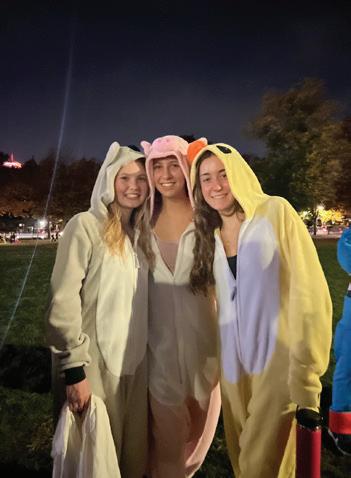


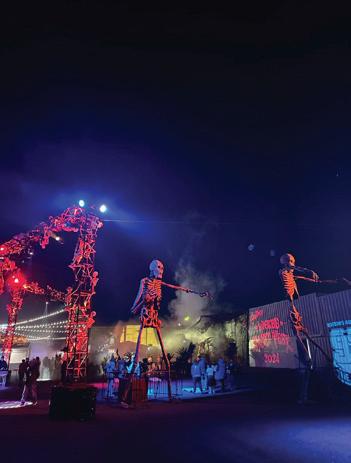






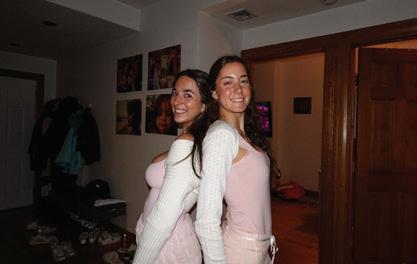


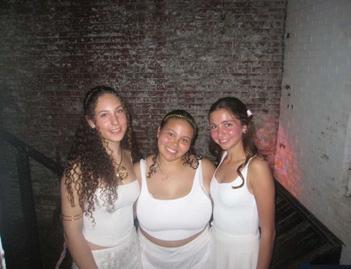
Fueled by a public rivalry between superstars Caitlin Clark and Angel Reese, the Women’s National Basketball Association (WNBA) has leveled up in popularity over the past year. In Boston, the sports capital of America, the WNBA is still largely out of sight and out of mind. This reality isn’t because of an underlying sexist prejudice in Boston but rather the result of corrupt actions from the league’s front office.
Although the Connecticut Sun is New England’s only WNBA team, they never come up in conversation among the local Titletown teams. But is it really fair to blame Bostonians for a lack of team spirit? After all, who has the time on a Monday night for a four-hour round trip from Boston to Mohegan Sun Arena in Uncasville, Connecticut?
When news broke out in July that a group led by Boston Celtics Minority Owner Steve Pagliuca came to an agreement with the Mohegan Tribe for the purchase and relocation of the Connecticut Sun to Boston, it seemed like there was a bright future for the WNBA in Boston. On top of buying the team for a WNBA record-breaking $325 million, Pagliuca’s bid guaranteed the construction of an additional $100 million practice facility and that playing would begin as early as 2027 at TD Garden. The Mohegan Tribe signed the deal, and Massachusetts Governor Maura Healey declared July 15 “WNBA Day in Boston,” enthusiastically stating: “We’re ready for a WNBA team in Boston.” Awaiting only approval from the WNBA Board of Governors, it seemed like the Sun’s move to Boston was right around the corner. But then the story went cold.
“You
read that correctly. The Commissioner of the WNBA herself was responsible for restricting the league’s growth.”
With the Boston Celtics entering another season without a WNBA counterpart, I decided to get to the bottom of what happened. It turns out WNBA Commissioner Cathy Engelbert never presented the offer to the league’s board of governors, stalling out the deal’s month-long exclusivity window. Yes, you read that correctly. The Commissioner of the WNBA herself was responsible for restricting the league’s growth. At Mohegan Sun Arena, the Sun saw an average of 8,451 fans per game last season. The two times they played at TD Garden? Sold-out crowds of 19,000. If the numbers speak for themselves, why would the league be against the team relocating?


“The first time I took my son swimming, he sank right to the bottom because he is just so dense. No, I’m being serious. He is so dense.”
—US Math Teacher
Tom Randall
“Why aren’t you running cross country? You don’t want to have any friends?” —Cross Country Head Coach
Charlie O’Rourke to Callum Sullivan ’29


“Why does everyone think I’m adopted and not Jayden?” —Josh Resnick ’29
“Because you have red hair and don’t look like your brother.” —Matias Egan ’28

“I’m going to throw up!” —Ella Botein ’26 before her Spanish skit
“This isn’t war. Don’t throw up here.” —US Spanish Teacher Rosario Sánchez Gómez

The WNBA claimed that Boston had to “wait its turn.” The WNBA denied the bid because it “broke procedure” by being proposed outside of the expansion window, which ended in January 2025. The league claimed that focus should be on the three new franchises, which were awarded on June 30 to Detroit, Philadelphia and Cleveland, and that priority for future expansion should be given to the nine other cities that applied before the deadline.
While everything the WNBA claimed may be true, I still couldn’t understand why the creation of new teams in other parts of the country had anything to do with the relocation of the Sun to Boston.

The truth is that the WNBA has a separate, corrupt motive at play: money. By blocking the deal and pushing Boston off to a later expansion window, the league would receive a much larger $250 million expansion fee from the city if a new team were created. With the approved new teams entering the WNBA over the next four years, it’s expected that the next expansion window won’t be until 2030. In the meantime, the WNBA has floated the idea of buying the Suns themselves and relocating the team in a sale to Houston, a city that has “already made an expansion bid.” In doing so, the league would be denying Boston its relocation deal, only to make a fatter cut by doing one themselves. Talk about a gross conflict of interest.
It’s hard to dismiss the idea that corruption is at hand, especially when Connecticut Senator Richard Blumenthal has issued the WNBA a warning against potential antitrust law violations.
With the next few years looking like rebuilding seasons for the Celtics, and the WNBA riding a wave of nationwide attention, now is an ideal time for a women’s basketball team to come to Boston. If it can’t be the Sun, okay, but there’s no assurance that these pristine conditions will remain for the next four years. Boston is an untapped market for the sport, and it would be sad to see the future growth of the league sacrificed by administrative greed today.